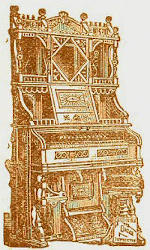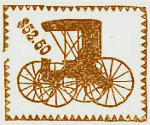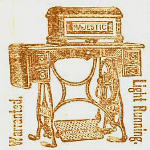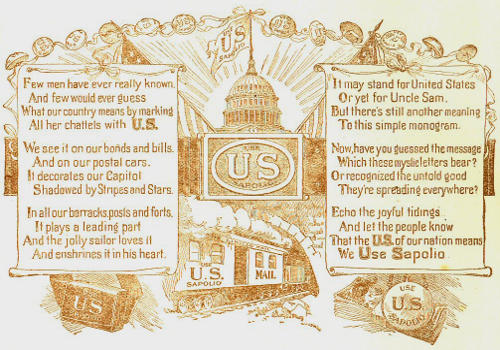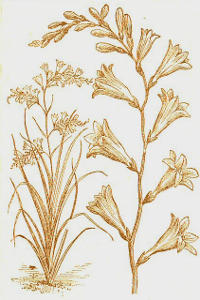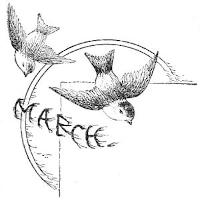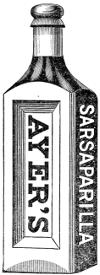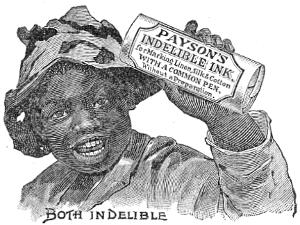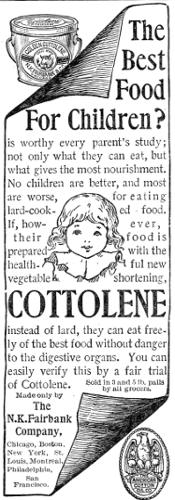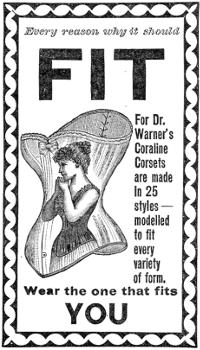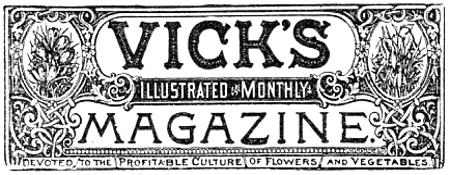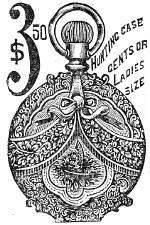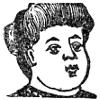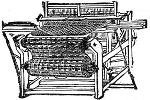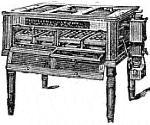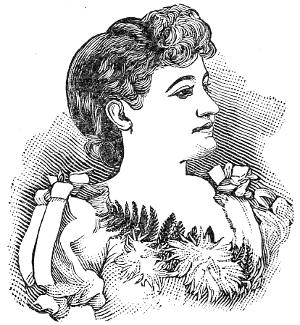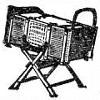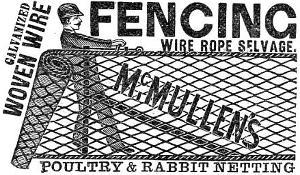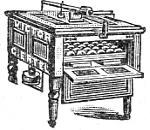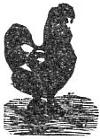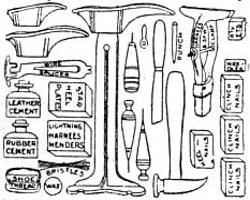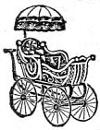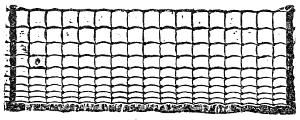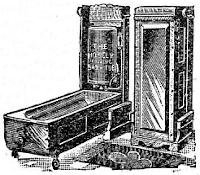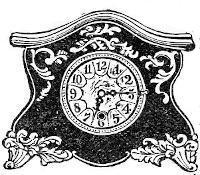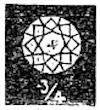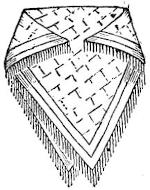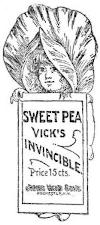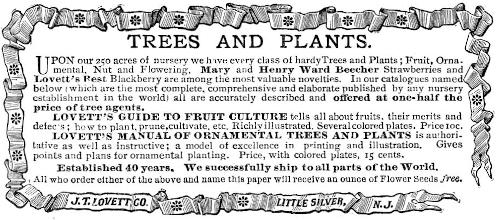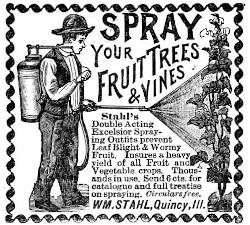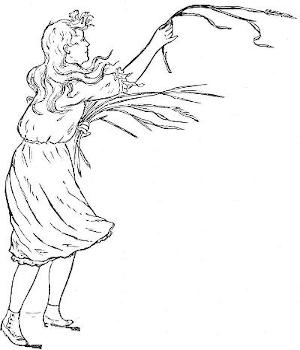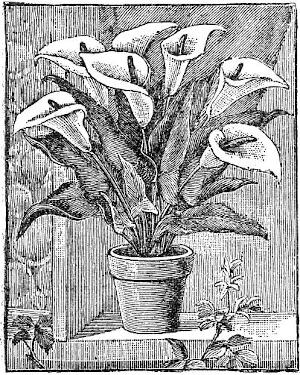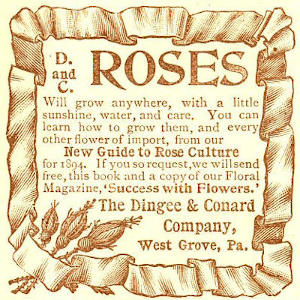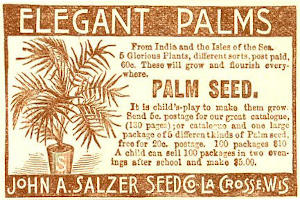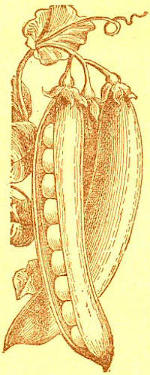*** START OF THE PROJECT GUTENBERG EBOOK 63196 ***

VICK’S
ILLUSTRATED MONTHLY
MAGAZINE.
Devoted to the Profitable Culture of Flowers and Vegetables.
Vick Publishing Co.
Fifty Cents Per Year.
ROCHESTER, N. Y., MARCH, 1894.
Volume 17, No. 5.
New Series.
COUGHS AND COLDS
are only the beginning. Lungs are weakened
next, the body becomes emaciated, and then
the dreaded Consumption Germ appears.
Scott’s
Emulsion
the Cream of Cod-liver Oil and Hypophosphites,
overcomes Coughs and Colds, strengthens
the Lungs, and supplies vital energy.
Physicians, the world over, endorse it.
BABIES AND CHILDREN
and Weak Mothers respond readily to the nourishing powers of Scott’s
Emulsion. They like the taste of it, too.
Don’t be Deceived by Substitutes!
Prepared by Scott & Bowne, Chemists, New-York City. Druggists sell it.
ORGANS $27.50 up
PIANOS, $175 up
FREE:
Our large 24-page
Catalogue, profusely
illustrated, full
of information on
the proper construction
of Pianos and
Organs. We ship on
test trial, ask no
cash in advance, sell
on instalments, give
greater value for
the money than any
other manufacturer.
Send for this book
at once to
BEETHOVEN ORGAN CO.,
WASHINGTON, N. J.
P. O. Box 280
☞ SAVE MONEY
| $90 Top Buggy |
$52.50 |
| $65 Top Buggy |
36.75 |
| $75 Spring Wagon |
42.25 |
| $40 Road Wagon |
24.75 |
| $130 4-Pass Surrey |
77.50 |
| $15 Texas Saddle |
8.25 |
| $15 Cowboy Saddle |
25.00 |
Single Harness $3.75, $5.25 and $10, same as sell for $7,
$10 and $18, Double Team Harness $12, $17, $20, same as
sell for $20, $30, $35. We ship anywhere to anyone at
WHOLESALE PRICES with privilege to examine
without asking one cent in advance. Buy from
manufacturers, save middlemen’s profits. World’s
Fair medals awarded. Write at once for catalogue and
testimonials free. CASH BUYERS’ UNION,
158 W. Van Buren St., B3, Chicago, Ill.
Death to High Prices!
Buy Direct from the Factory
and save agents’ and canvassers’
commissions. Hereafter
we shall sell the Majestic direct
to the consumer at factory
cost. The Majestic is recognized
as the best machine for
family use, and has always
been sold by our agents for
$60. For a limited time we
shall sell it for $22 and furnish
all attachments free of charge.
Shipped on approval anywhere.
Send for a sample of its work and catalogue.
THE TILTON S. M. CO., 275 Wabash Av., Chicago, Ill.
Few men have ever really known,
And few would ever guess
What our country means by marking
All her chattels with U.S.
We see it on our bonds and bills,
And on our postal cars,
It decorates our Capitol
Shadowed by Stripes and Stars.
In all our barracks, posts and forts,
It plays a leading part
And the jolly sailor loves it
And enshrines it in his heart.
It may stand for United States
Or yet for Uncle Sam,
But there’s still another meaning
To this simple monogram.
Now, have you guessed the message
Which these mystic letters bear?
Or recognized the untold good
They’re spreading everywhere?
Echo the joyful tidings
And let the people know
That the U.S. of our nation means
We Use Sapolio.
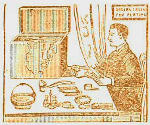
AGENTS $10 a day at home
selling LIGHTNING PLATER
and plating Jewelry, Watches,
Tableware, Bicycles, etc. Plates
finest jewelry good as new, and
on all kinds of metal with gold,
silver or nickel. No experience.
Anyone can plate the first effort.
Goods need plating at every
house. Outfits complete. Different
sizes, all warranted. Wholesale
to agents $5 up. Big profits,
good seller. Circulars free.
H. F. Delno & Co. Dept. No. 6, Columbus, O.
HALM’S ANTI-RHEUMATIC AND
ANTI-CATARRHAL CHEWING GUM
Cures and Prevents Rheumatism, Indigestion, Dyspepsia,
Heartburn, Catarrh and Asthma. Useful in
Malaria and Fevers, Cleanses the Teeth and Promotes
the Appetite. Sweetens the Breath, Cures Tobacco
Habit. Endorsed by the Medical Faculty.
Send for 10, 15 or 25 cent package. Be convinced.
Silver, Stamps or Postal Note.
Geo. R. Halm, 140 W. 29th St., New York
Montbretias for Spring Planting.
An order of plants belonging to the Iris family, are natives of Africa, and their general appearance
is that of the gladiolus, 18 inches high. Bloom profusely from July to October, throwing out spike
after spike of beautiful blossoms. Hardy south of the Ohio; North, lift in fall and keep in dry sand.
Crocosmiflora. This is a hybrid variety, having scarlet flowers about one and one half inch in
length, borne numerously in a long panicle standing well up above the foliage, considered hardy.
Pottsii. Flowers bright yellow, flashed on the outside with brick-red; very ornamental and hardy.
Rosea. Flowers rose colored. Mixed. All colors.
Named varieties 5c. each; 6 for 25c.; 12 for 40c. Mixed 5c. each 6 for 20c.; 12. for 35c.
POPULAR SELECTED COLLECTIONS.
To all who want good sensible Collections for the Flower and Vegetable Garden we can recommend
either of the following. All of the seeds contained in them are our regular sized packages, and first
class in every respect. They give to our customers a good assortment, best adapted to produce a continued
succession of the most useful kinds throughout the year.
Several thousand of our Collections are sold annually, and to the same people, which shows that
they are perfectly satisfactory.
FLOWER SEEDS.
- No. 1—Twenty Varieties Choice Annuals, $1.00.
- No. 2—Forty Varieties Choice Annuals, $2.00.
- No. 3—“Beauteous” Collection of 60 Varieties of the Finest
Annuals, Biennials and Perennials, $3.00.
- No. 4—“Perfection” Collection of 100 Varieties of the Finest
Annuals, Biennials and Perennials, $5.00.
VEGETABLE SEEDS.
- No. 5—Twenty-three Varieties, for Small Garden, $1.00.
- No. 6—Forty-six Varieties. All Leading Vegetables. $2.00.
- No. 7—“Giant” Collection ($4.00 worth) of Finest Varieties
of Vegetables for Family Garden, $3.00.
- No. 8—“Mammoth” Collection ($6.50 worth) of Finest Varieties
of Vegetables for Family Garden, $5.00.
FLORAL GUIDE, 1894,
The PIONEER CATALOGUE
of Vegetables and Flowers.
Contains 112 pages 8 × 10½ inches, with descriptions that describe, not mislead; instructions that instruct, not exaggerate.
The cover is charming in harmonious blending of water color prints in green and white, with a gold background,—a dream of beauty. 32 pages
of Novelties printed in 8 different colors. All the leading novelties and the best of the old varieties. These hard times you cannot afford to run
any risk. Buy Honest Goods where you will receive Full Measure. It is not necessary to advertise that Vick’s seeds grow, this is known the
world over, and also that the harvest pays. A very little spent for proper seed will save grocer’s and doctor’s bills. Many concede Vick’s Floral
Guide the handsomest catalogue for 1894. If you love a fine garden send address now, with 10 cents, which may be deducted from first order.
$360.00 CASH PRIZES FOR POTATOES.
JAMES VICK’S SONS, Rochester. N. Y.
[65]
Vick’s Magazine.
Vol. 17. ROCHESTER, N. Y., MARCH, 1894. No. 5.
MARCH
Shifting winds and lowering sky—March.
Bleak and bare the brown fields lie—March.
Winter’s spectre now is laid,
Yet Spring lingers, half afraid.
Haste, oh Spring, your tasks are set, March!
You are late, do you forget? March!
Long before this time last year,
Bluebird and his mate were here.
MABEL RAY’S LESSON.
BY ROSE SEELYE-MILLER.

Times had been hard,
harder than common this
past year, and it seemed to
Mabel Ray as though there
was little bright to look forward
to, and less to encourage
her in trying to do
right, trying to be the Christian
she wanted to be some
years ago. She had married
Harry Ray three years
previous; he was a thriving
young merchant, but the past year it had seemed
to the young wife as if he had grown taciturn
and almost fretful if she wanted money for any
little thing which she deemed necessary. Only
this morning he had refused her money for the
fur cape that she really needed so much, especially
if they were going to her folks for New
Year’s day. She had always had what she
wanted when at home, and if Harry begrudged
her the necessities of life, why, she almost believed
she had better go back to that home, for
she was an only daughter and was idolized by
her parents. She sat and thought, and thought,
of her wrongs until the tears came, and then,
after having a good cry, she went into the conservatory
and began picking flowers for the
church decoration in which site was to take
part. There was to be a concert and recitations
and such entertainments, and the funds were to
go to help the needy ones in the parish. For
there were many who needed, many men were
out of work, and their families were destitute
indeed. Mabel was always ready for work of
this kind, it relieved the tedium of the days
when Harry was at the store, and then, be it
known to you, although Mabel would have
blushed had she realized it herself, she liked the
notices in the city personals about the charming
and philanthropic Mrs. Ray who took such a
prominent part in every good work.
Her time was her own; there were no little
ones for her to care for; her household was managed
by a competent housekeeper who looked
well to the domestic arrangements; so, altogether,
Mrs. Ray rather needed something to give her
an idea of usefulness. She was selfish, I am
sorry to say, but when you think that she was an
only child, reared in luxury, with everything she
desired procured for her, it is no wonder that
she learned to think that what she wanted was
the first thing to be considered.
Harry Ray really loved his wife, but he was
bearing a heavy burden of financial care, and
then, besides, he did not possess the means that
Mabel’s father had. He would do anything,
sacrifice anything for her, but she seemed thoughtless
about his sacrifices, and did not realize that
perhaps she too had a duty to perform.
She came home from decorating the church
that afternoon in better spirits, but was almost
vexed when Harry assured her it would be impossible
for him to attend the Charity function
with her that evening. “Wrap yourself up well,
Mabel,” Harry said thoughtfully, “and let the
coachman await you.” He looked almost wistfully
at her bright young beauty and longed for
a word of sympathy and help from her, but none
came. He looked worn and worried, and a
thoughtful wife would have noticed this long
before, but Mabel had not been taught to notice
others in that way.
So Harry went to his work in his office, and
Mabel, dressed richly, went to the Charity function,
where she expected to sing. The evening
passed pleasantly to Mabel, for she loved a brilliant
scene and the compliments she always
received.
The next day she was one of a committee to
dispense the various gifts among the poor. She
rose early for her, and with several others she
visited such haunts of misery as she had never
dreamed of. Poverty had always been a rather
pleasant thing in her mind where people were
always holding some sort of meetings to relieve
it, and where kind hearted women were taking
chicken broth or cups of jelly to others who lay
in bed; she never really thought that perhaps it
would be pleasanter to make one’s own chicken
broth or furnish one’s own jelly, or that perhaps
the one who lay in bed might do something besides
just simply lie there; she did not realize
the tragedy of many of those lives where poverty
binds and sickness holds with chains invincible
beyond all human aiding.
There was more wretchedness depicted in the
squalid homes she visited than she had ever
dreamed of, there was not only poverty but there
was dirt, and there was suffering, and she began
to wonder if there were not other things needed
by the poor besides chicken broth and jelly; she
thought soap would not be misplaced, and that
clothes would find lodgement, she was sure
flowers would be welcomed by some, and she
went home with her heart really aroused from
its selfish stupor. Harry did not come home to
tea, and it was so late before he did come that
being very wearied she retired, and soon fell
asleep. But here, even, she was not free, she
seemed to be in the midst of a white-robed
throng who went about ministering to the needs
of others, and when she spoke to them they only
said “Even Christ pleased not Himself,” and
winged their way on their errands of mercy, and
then she seemed transported to the sunny fields
where flowers bloomed and birds sang their
sweetest carols; there were certain ones gathering
the flowers and when she spoke to them they
said “Even Christ pleased not Himself.”
And then she was transported to the city and
into the haunts of misery and she saw a wan-faced
woman going into a poor hovel with a
blossom in her hand that she had picked from
where it had fallen from some fair lady’s bouquet.
She placed it carefully in a pitcher with
a broken spout and turned the fairest side of the
flower toward a sick one lying upon a pallet of
straw, and when she looked a halo seemed to
surround the flower and a voice said “Even
Christ pleased not Himself.” And suddenly
she seemed to be in her husband’s office, and
there sat Harry, his face was haggard, and there
were tense lines about his mouth, and he seemed
trying in vain to make the accounts tally in the
ledger before him, and ruin and disaster embodied
seemed looking in upon him as he
worked, and finally he laid down his pen, saying
“I can do no more—if it were not for
Mabel.”
Then she was in her own beautiful home and
everything seemed going on strangely; the flowers
in the conservatory had withered and died
because they lived to please themselves, and so
it seemed with everything in the house; the
housekeeper was keeping house to please herself,
the cook was not going to serve the dinner
because it did not please her to do so, and so it
[66]
went, and she reached her room and there she
found herself in ease and luxury, taking no thought
for others, and seeking only how she might
please herself; and then there seemed to be the
roaring of a fire and she saw the house and all
therein consumed, but she saw the woman who
had carried the broken flower to the sick child
coming to help her, and then Harry took her in
his arms, and she knew that these were safe because
they had not lived to please themselves.
After awhile she woke and hearing a step
upon the stairs she slipped on a warm dressing
gown and went out softly to meet Harry. He
was surprised and there was that anxious look
upon his face that she had seen in her dream.
She drew him into the parlor and seated him in
an easy chair, and then smoothed the wrinkles
from his brow and begged him to tell her of his
troubles. So the husband and wife conferred
together, and both bearing the burden it grew
lighter, and after a time it passed away. Mabel
seemed different thereafter, her dream was so
realistic that her very heart seemed changed, and
upon its tablets were written in indelible letters,
“Even Christ pleased not Himself.” She did
not care to figure in charity functions where she
would be praised of men, but she sought out the
needy and tried faithfully to aid them. Her aid
was given so unostentatiously, and with such humility
and earnest sympathy, that the poor soon
learned to love her, and her flowers bloomed not
in vain, for they bloomed for the sick and sinning,
for the poor and needy, and I trow that in
sowing good seeds upon earth she will reap a
heavenly harvest that will surprise her. For
she has learned the sweetness of the words
“Even Christ pleased not Himself.”
CURIOUS ARCHITECTS.
There is no topic in natural history so interesting
as the architecture of birds; in
the building of their nests they are exceedingly
ingenious. We may well learn a lesson from
the patience, diligence and perseverance which
they display. Just as men are skilled in different
mechanical employments, so we find in the
bird tribe miners, masons, carpenters, weavers,
basket-makers and tailors.
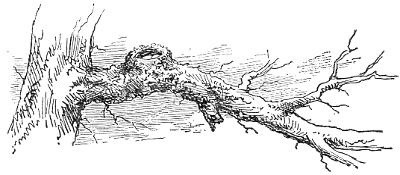
HUMMING BIRD’S NEST.
The humming bird constructs its nest of the
finest silky down, and of cotton, or if these are
not available, some other similar material. The
inside is lined in the most delicate manner with
soft substances; the outside is covered
with moss, usually the color of the bough
or twig to which the nest is attached,
thus giving it the appearance of an excrescence.
The delicacy and ingenuity
of workmanship and skill could hardly
be excelled by human art.
The humming bird is the
“fairy of the feathered race”—the
smallest and most beautiful—and
they are found almost all
over this continent. Most of
them, however, dwell in the far
South, where flowers are ever in
bloom, and summer reigns all
the year round. One species
alone visits our chill Northern States—the
humming bird with the ruby throat.
It comes to us in July and is very shy;
its stay is very short, for toward the first of
September it departs to a warmer climate.
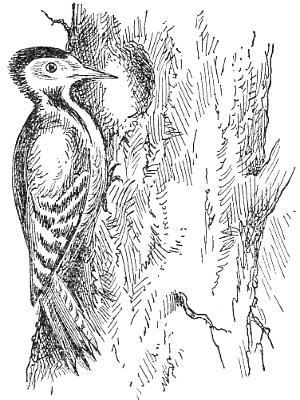
WOODPECKER DRILLING A HOLE FOR A NEST.
It is only in tropical countries that the several
species of humming bird are seen in their abundance
and variety. The islands between Florida
and the main land of South America literally
swarm with them. In the wild and uncultivated
parts they inhabit the magnificent forests overhung
with rare plants, whose blossoms vie in
beauty with the jewel-like brilliancy of these
animate gems of the air. In the cultivated portions
of the country they abound in the gardens
and seem to delight in society.
Lovely and full of nervous energy, these
winged gems are constantly in the air, darting
from one object to another, and displaying their
gorgeous colors in the sunlight.
When on a long journey, as
during migration, they pass
through the air in long undulations,
raising themselves to a
considerable height and then
falling so as to form a curve.
When feeding on a flower they
keep themselves poised in one
position as steadily as if suspended
on a bough—making a
humming sound with the rapid motion
of their wings.
In disposition these little creatures
are bold and pugnacious. In defending
their nests they will attack
birds five times their size and drive
them off. When angry, their motions are very
violent and their flight as swift as an arrow.
Often the eye is incapable of following them,
and their shrill, piercing note alone announces
their presence.
Among the most dazzling of this brilliant tribe
is the bar-tailed humming bird of Brazil. The
tail is forked at the base, and consists of five
feathers, graduated one above another, at almost
equal distances. Their color is of the richest
flame; the upper part of the body is golden
green, and the under part emerald.
There are more than a hundred kinds of these
birds, and all are noted for their surpassing beauty.
What a beautiful conception in the author
of nature were these exquisite little creatures!
It is as if the flowers had taken wings, and life,
and intelligence, to share in the sports of animal
life.
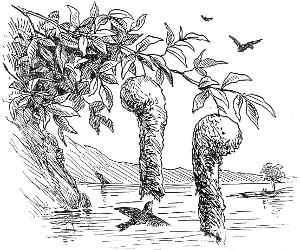
NESTS OF THE BOTTLE BIRD.
The nest of the golden-crested wren, a most
beautiful bird found in England and other parts
of Europe, is a fine example of weaving. It is
made of moss and lichen, and lined with feathers;
it has a very small entrance at the top and
the interior of the nest is also small, bearing no
proportion to the size of the structure. The
weaving of this nest is a work of great labor and
assiduity, and compared with the bulk of the
bird, it is of large dimensions.
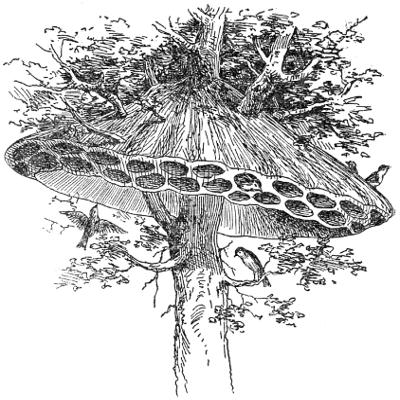
NESTS OF SOCIAL WEAVERS.
The nest is suspended from the under surface
of a fir branch, thickly clothed with foliage, by
which it is almost entirely concealed and partly
protected from the rain. Thus, beneath a natural
canopy, this little bird rears her brood,
whose cradle swings to and fro with every
breeze. The eggs are from seven to ten in
number, and of a pale brown color.
A naturalist who watched a nest containing
eight small birds with a powerful opera glass,
observed that the parent birds came to the nest
with food every two minutes, or upon an average
thirty-six times in an hour; and this continued
full sixteen hours a day, which, if equally
[67]
divided between the brood, each would receive
seventy-two feeds, the whole amounting to five
hundred and seventy-six!
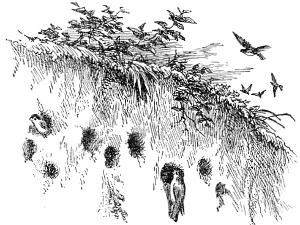
NESTS OF THE SAND MARTIN.
The woodpeckers are carpenters; they not
only bore holes in trees in search of food, but
they also chisel out deep holes in which to deposit
their eggs and rear their young. They
generally build their nest in May, selecting an
old apple tree in the orchard; the boring is first
done by the male, who pecks out a circular hole;
as the work progresses, he is occasionally relieved
by the female. They both work with
great diligence, and as the hole deepens they
carry out the chips, sometimes taking them some
distance to prevent discovery or suspicion. The
nest usually requires a week to build, and when
the female is quite satisfied she deposits her eggs,
generally six in number and of a pure white
color.
A bird called the grosbeak builds a nest
shaped like an inverted bottle with a long neck,
through which it passes up to a snug little chamber
above. The nest is skillfully constructed of
soft vegetable substances, sewed together in a
wonderful manner, and suspended from a twig
of a bush.
The social weaver is found in the
south of Africa. Hundreds of these
birds, in one community, join to form a
structure of interwoven grass containing
various apartments, all covered by a
sloping roof impenetrable to the heaviest
rain, and increased year after year as the
population of the little community may
require.
A traveler, returned from a journey
through South Africa, writes: “A tree
with an enormous nest of these birds was
quite near where our party camped for
the night. I dispatched a few men with
a wagon to bring it to the camp that I might
open the hive and examine the nest in its minutest
parts. When it arrived I cut it to pieces
with a hatchet, and saw that the chief portion
of the structure consisted of grass, without any
mixture, but so compact and firmly woven together
as to be impenetrable to the rain. This
is a canopy under which each bird builds its particular
nest; the canopy projects a little, which
serves to let the water run off when it rains.
The nest contained three hundred and twenty
nests, and it was calculated that the number of
birds would exceed six hundred in this one
nest alone.”
The bottle-nested sparrow is a basket maker;
it is found in India and is a very intelligent bird.
It resembles our native sparrow in some particulars,
but its color is brown and yellow. It associates
in large communities and builds its nests
on palm trees. It is formed in a very ingenious
way, by long grasses woven together into the
shape of a bottle, and it is then suspended at the
extremity of a branch, in order to secure the
eggs and young birds from numerous enemies,
such as serpents, monkeys and other animals
which infest that part of the world.
These nests excel in the neatness and delicacy
of their workmanship. They contain several
apartments intended for different purposes;
in one the female deposits her eggs; in another
is stored the food which the male gathers
for his mate during her maternal duties, and a
third is the sleeping apartment for the male
bird.
The sand martin is a most curious member
of the swallow tribe. It appears in the spring
a week or two before the common swallow,
and it is fond of skimming swiftly over the surface
of the water. This bird makes a hole in
a sand bank, sometimes two feet deep, at the
extremity of which it constructs a loose nest of
fine grass and feathers, in which it rears its
young brood. The beak of the sand martin is
like a sharp little awl, very hard, and tapering,
suddenly to a point.
The tailor bird is not the least interesting of
the bird family; it has a curious bill which it
uses like a needle, and it forms its nest by sewing
the materials together instead of weaving.
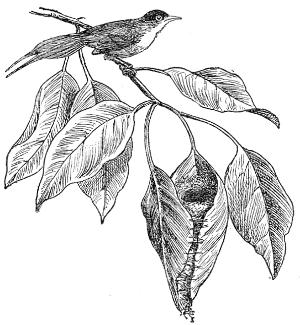
NEST OF TAILOR BIRD.
“The tailor bird,” says Darwin, “will not
build its nest to the extremity of a tender twig,
but makes one more advance to safety by fixing
it to the leaf itself. It picks up a dead leaf and
sews it to the side of a living one, its slender
bill serving as a needle, and its thread some fine
fibers; the lining consists of feathers, gossamer
and down; its eggs are white; the color of the
bird light yellow; its length three inches; its
weight three-sixteenths of an ounce; so that the
materials of the nest and the weight of the bird
are not likely to draw down a habitation so
slightly suspended.”
The different methods of nest building evidently
result from the peculiarities of the birds
themselves combined with their surroundings.
Will these styles of architecture be changed or
further developed?
Henry Coyle.
VICK’S FLOWERS.
What radiance do I see?
What color-wave outflows,
Making the wilderness rejoice
And blossom like the rose?
From sea to sea it pours,
From east to western strands,
Softening the stern Atlantic shores,
Brightening Pacific sands.
The South-land grows more sweet;
By broad blue Northern lakes,
Fair as auroral flushes fleet
The fragrant flower-tide breaks.
Our fertile vales make room
For this benignant grace;
The prairie’s wealth of native bloom
Gladly to this gives place.
O, lovely enterprise,
Refining where it goes,
Making the wilderness rejoice
And blossom as the rose!
“Only the Scars Remain,”
Says Henry Hudson, of the James
Smith Woolen
Machinery Co.,
Philadelphia,
Pa., who certifies
as follows:
“Among the
many testimonials
which I see
in regard to certain
medicines
performing
cures, cleansing
the blood, etc.,
none impress me
more than my
own case.
Twenty years
ago, at the age
of 18 years, I had
swellings come
on my legs,
which broke and
became running
sores.
Our family physician
could do
me no good, and it was feared that the
bones would be affected. At last, my
good old
Mother urged me
to try Ayer’s Sarsaparilla. I took three
bottles, the sores healed, and I have not
been troubled since. Only the Scars
remain, and the memory of the
past, to remind me of the good
Ayer’s Sarsaparilla has done me.
I now weigh two hundred and twenty
pounds, and am in the best of health.
I have been on the road for the past
twelve years, have noticed Ayer’s Sarsaparilla
advertised in all parts of the
United States, and always take pleasure
in telling what good it did for me.”
Ayer’s Sarsaparilla
Prepared by Dr. J. C. Ayer & Co., Lowell, Mass.
Cures others, will cure you.
[68]
LINES TO A SKUNK CABBAGE.
Oh, life grotesque! How, whence did spring
The thought that gave thee blossoming?
How comes thy strange offensive bloom
Near knolls that give sweet violets room?
Sweet violets, which fill the air
With perfumed incense of a prayer
That, floating to the world above
Calls blessings from the soul of Love.
But thou, mephitic bloom! thou hast
A thought in thee of ages past,
When songs of love were all unknown,
Ere earth had into beauty grown,
Ere rippling brook and soughing pine
Had turned her prose hills into rhyme;
When all was dark, and cold, and bare,
Thou hadst, perhaps, a mission there;
And that is why, ’neath spring-time snows
Thy curious spathe so early grows.
Hast thou no mission now, strange flower,
Happier to make spring’s early hour?
Hark! from thy close-wrapped heart doth come
The working bee’s glad, soundful hum,
Where loads of pollen he doth find
His waxen honey cells to bind.
So, thou hast place in fields of use,
And vain are now words of abuse—
Giving the best thy heart doth hold
To help the workers of the world.
And giving thus, with patient grace,
Doth baser qualities efface,
And in a better, higher sphere
Thine inner beauty doth appear,
And thy developed soul shall be
Violet-sweet eternally.
These lines were suggested by a spathe of the
skunk cabbage sent me by my brother, W. S. Ripley,
of Wakefield, Mass., who mentioned in his letter to me
when the specimen was sent that he stopped “to
watch the bees go in at the aperture on one side of
the spathe, and listened to their loud humming inside,
as they laid on their load of pollen.” In Thoreau’s
“Early Spring in Massachusetts,” page 172, in writing
of this plant he says: “All along under that bank
I heard the hum of honey bees in the air, attracted by
this flower. Especially the hum of one within a spathe
sounds deep and loud.”
THE NEW FRENCH CANNAS.
I do not know of any class of plants that have
attracted so much attention or have been so
much admired during the past season as the new
large flowering French cannas. And for effectiveness
on lawns in large beds or masses, or as
single specimens in the mixed border, nothing
can be more tropical and impressive. They are
really plants for everybody as they are entirely
free from insect pests, and require but little care
and attention to grow them to perfection. They
succeed well in all kinds of weather, wet or dry,
and are not injured in the least by the severe
storms of wind and rain that we so often experience
during the summer season.
They bloom without intermission from June
until they are destroyed by frost; the spikes of
large flowers somewhat resemble gladiolus but
are really more effective and showy as their
brilliant colors show so grandly against their
tropical foliage. Most, if not all, of the varieties
grow on an average about three feet in
height, and the flowers range in color from deep
crimson to pure yellow, including all the intermediate
shades, many being so beautifully
marked that they are frequently compared to
orchid flowers.
To grow these cannas to perfection as well as
to enable them to properly develop themselves,
they should be given a very deep heavily enriched
soil, and as soon as hot, dry weather sets
in mulched to the depth of at least two inches
with good stable manure, and if the opportunity
offers, water copiously during seasons of drought.
With this treatment a single tuber will make a
clump three or four feet in diameter in a single
season; this will give one some idea of the immense
amount of foliage and flowers a single
specimen will produce.
The plants should not be planted outside until
the weather becomes warm and settled, which
in this vicinity is about the tenth of May, and as
soon as the foliage has been destroyed by the
frost it should be cut off, and the tubers dug and
stored underneath the greenhouse stage, or in
some other situation, where a temperature of 55°
is maintained, until the time arrives for planting
them outside again.
Or the plants can be lifted on the approach of
cold weather, divided, potted up, and grown on
for decorative purposes in either the greenhouse
or window garden. This is a very safe way to
winter over the large flowering cannas or any
other variety of which one’s stock is limited.
When grown as pot plants for winter decoration
the cannas should be given a compost consisting
of two-thirds turfy loam, one-third well
decayed manure and a good sprinkling of bone
dust, mix well and use the compost rough. The
plants should be given as light and sunny a situation
as possible and a temperature of 55° to 60°.
They should also be freely watered both overhead
and at the roots, and as soon as the pots
become well filled with roots a little liquid ammonia
can be given occasionally or else they
must be shifted into larger pots.
Propagation is effected by a careful division
of the clumps, and where the plants are to be
kept in a state of rest the operation should be
performed when they are being planted out in
May. In dividing leave two or three eyes or
shoots to each plant.
Of the many varieties now listed in catalogues
the following are the most desirable and distinct:
Alphonse Bouvier is the grandest deep red
variety known, both truss and flowers being very
large, and the plant makes a most luxuriant
growth of deep red foliage. In color the flowers
are of a rich velvety red.
Capt. P. de Suzzini has handsome light green
foliage and is the most beautiful of all the spotted
varieties. Its flowers are of a rich shade of canary
yellow beautifully spotted and dashed with red.
Francois Crozy has bright green foliage and
very large flowers which are of a bright orange
bordered with a narrow edge of gold—a very
rare and desirable color in cannas.
Madame Crozy grows about three and a
half feet in height and has broad bright green
foliage. The flowers, which are produced in
massive spikes, are of a bright crimson scarlet
beautifully bordered with gold. The plant commences
to bloom when about one foot in height.
Nellie Bowden, in all respects this is identical
with Madame Crozy except in the color of
its flowers which are of a rich golden yellow.
One of the most distinct and beautiful of cannas.
Paul Marquant has dark green foliage and
very large handsome flowers of a bright salmon
scarlet. A very showy variety.
Star of 1891 is so well and favorably known
as to require no description. It is the best of
all for pot culture, as it is of dwarf growth and
very free-flowering. The flowers are of a bright
orange scarlet occasionally edged with yellow.
Floral Park, N. Y.
Chas. E. Parnell.
THE DIFFERENCE.
It makes all the difference between nice thrifty
plants or scraggly looking ones whether we
read, mark, learn, and inwardly digest a floral
magazine. In walking on the street, the appearance
of the windows or front yards tells you
whether the postman leaves a floral weekly or
monthly. Six weeks ago I saw a row of empty
pots right in the sun, and often an old man was
poking up the soil with his penknife to see if his
bulbs had started. You see he didn’t read up
about hyacinths, but potted them and put them
right in the sun. I can imagine his saying to
his wife, “It’s money thrown away to buy
bulbs; they probably are too old to grow and
I’ve been cheated.” So the poor seedsman gets
the blame, and not his own ignorance. Here is
a window with leggy looking geraniums in it,
just a few leaves on top of the long stems. Now
a little reading in a floral magazine would have
shown her, after blooming all summer, the place
for them is the cellar. Ah! here is a window
that shows intelligence. The hyacinths and
jonquils are showing their buds, moved to the
window from the dark corners where they have
been for weeks forming vigorous roots. Here
are primroses in bloom, and oxalis, and a scarlet
nasturtium makes the room bright on a cloudy
day, and in a corner I can see the Palm Latania.
She takes the magazines and knows what are
good winter plants for amateurs.
In summer one can pick out the magazine
lawns and gardens. Here is one where the man
has two shapely maple trees in front, and has
pruned his “Jac” rose so that it is loaded with
blossoms, and in a circular bed he has put a caladium
in the center, and this shows off the
gladiolus in every shade around it. But the
next front yard is enough to set one’s teeth on
edge. Actually, here is a large square bed with
a tall candidum lily in each corner and, inside,
petunias, zinnias, asters and marigolds in one
blaze of color. The whole effect is like a crazy
quilt thrown over an old fashioned four-posted
bedstead. One sees the roses eaten of worms
and bugs, or planted by the sunflowers and looking
ashamed at their surroundings; whereas the
magazines tell us again and again that roses
need to be watched continually and sprayed to
keep off the insects, and to plant by themselves.
Now for the moral. Let us all show, and lend
our florals, and urge the people to subscribe.
Anna Lyman.
“WORTH A GUINEA A BOX.”
BEECHAM’S
PILLS
CURE
SICK HEADACHE,
DISORDERED LIVER, etc.
They Act Like Magic on the Vital Organs,
Regulating the Secretions, restoring long
lost Complexion, bringing back the Keen
Edge of Appetite, and arousing with the
ROSEBUD OF HEALTH the whole physical
energy of the human frame. These Facts
are admitted by thousands, in all classes of
Society. Largest Sale in the World.
Covered with a Tasteless & Soluble Coating.
Of all druggists. Price 25 cents a Box.
New York Depot, 365 Canal St.
When a tradesman can indulge in a suburban
home or a summer cottage it will
often happen that he will desire to keep a family
horse. If he doesn’t want a horse he will often
want a cow or chickens. In the accompanying
sketch A is a site provided for one or other of
these animals, and it is designedly given a prominent
position that its architecture may receive
treatment in consonance with that of the residence,
that it may be in unison with the surroundings,
and that it may supplant the useless
and ugly pavilions frequently seen.
The approach to the house is direct and convenient
for all points, unless the architect is perverse
enough to put the coal cellar on the opposite
side.
The boundary hedge is of Norway spruce with
room enough to grow and room enough to get
between it and the fence to clip it. I saw a
hedge on paper recently—between two groups
of shrubbery—which was not allowed room to
stand on end.
There is a small vegetable garden, 13, with a
border around it for blackberries, currants, raspberries,
strawberries and such like, and at the
end, 14, either a few fruit trees or flowering
shrubs. The porches, both back and front, are
but a single step above the roadway. The
rooms may or may not be another step above
them, depending somewhat upon the character
of the subsoil, etc. I have not arranged any
special drying ground, for cedar poles may be
set up in the center of any of the round beds, 1
to 8, and clothed with Japanese ivy, Euonymus
radicans, climbing hydrangeas and so on, and
have wires between them.
Now these beds may be further filled with
either bedding plants or select herbaceous plants.
I will assume that it is a summer cottage, and I
would then plant the ground as follows, which
would result in a very different how d’ye do
from that usually seen in such places: 1, Begonia
Evansiana; 2, Funkia grandiflora; 3,
Echinacea purpurea; 4, Aconitum Napellus variegata;
5, Lobelia cardinalis; 6, Sedum Sieboldii;
7, Veronica longifolia subsessilis; 8, six
distinct varieties of Phlox paniculata. These
beds may be varied greatly, but nothing of unreliable
character should ever be planted in
them. Number 1, for instance, might have a
tub of nelumbium in place of the begonia, not
that it is greatly better, but for variety and fancy.
Numbers 9, 9, 9, are shrubbery groups composed
of the following summer-flowering material,
disposed in such manner that all sides
may be seen, and mowed around, and giving
the longest possible margins for the space occupied.
There are but few trees to bloom after
July, they are chiefly Rhus semialata Osbeckii
and R. glabra; Dimorphanthus Mandschuricus;
Koelreuteria paniculata and Clerodendron trichotomum.
None of them are large. Of shrubs
there are a number, and it is strange that they
are so seldom used effectively. Garden shrubbery
looks more devoid of color in August here
than English shrubbery in midwinter. This
should not be with a list such as the following
to draw from and utilize. Just fancy what we
have—and the great artists we have—and tell
me if it should be.
There are the altheas, lots of them; Buddleia
Lindleyana; Calluna vulgaris; Clethras in variety;
Callicarpa purpurea; x Clematis in variety;
Clerodendron viscosum; Desmodiums; Dabœcia
polifolia; Daphne cneorum; Erica vagans;
Euonymus Sieboldianus; Hydrangea Hortensia
varieties; Hydrangea paniculata grandiflora;
Hypericum in varieties; Hibiscus roseus, etc.;
Indigofera Dosua; Kerria Japonica; Lespedeza
bicolor; Leycesteria formosa; Lagerstrœmia
Indica; x Lonicera Halleana; x Periploca
græca; Polygonum cuspidatum; Potentilla fruticosa;
Rubus odoratus; Rhodotypus Kerrioides;
Rhus copallina; Rosa rugosa; R. Wichuriana,
and several hybrids; Spiræa salicifolia, S. tomentosa,
S. Douglassii, and S. Bumalda if it is pruned
after flowering in spring; Tamarix Chinensis;
x Tecoma radicans; x Tecoma grandiflora; Vitex
agnus-castus; Vitex Negundo incisa, and a
large number of sub-frutescent plants of large
size, which may be substituted for such of the
shrubs as are tender north of Philadelphia.
Numbers 10 and 11 are prepared borders
which may well be planted with Hydrangeas
Hortensia, Thomas Hogg, etc., and interspersed
with the pink and white varieties of Lilium
speciosum. Numbers 12, 12 are plants of Sciadopitys
verticillata.
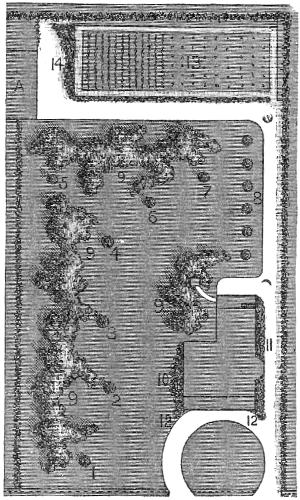
PLAN OF GROUNDS.
Climbers are marked x. South of Philadelphia
Bignonia capreolata, Magnolia grandiflora
and evergreen roses may be grown on walls.
Trenton, N. J.
James MacPherson.
ROSE LEAVES.
My rose bushes are almost as much admired
for their beautiful foliage as for
their lovely roses. “I never saw such handsome
leaves, why they look exactly like wax.”
This is an exclamation I am growing quite accustomed
to hear from friends, and it is really
true; but I think any one who grows roses as
house plants may have just as handsome foliage
if the proper care is taken of the plants. Once
or twice every week (just as is most convenient)
I wash every leaf with clean, weak soapsuds,
under side as well as upper side. With the
small-leaved Polyanthas it is too tiresome to
wash each leaflet individually, but the foliage
can be sprayed well, and then very carefully and
gently a branch of leaves may be wiped at once,
and in this manner one can go over quite a number
of plants in half an hour. The leaves may
be left without wiping, of course, but the foliage
is apt to be marred unless it is done, as the soapsuds
dries on the leaves in white, unsightly spots.
Roses treated in this way will very rarely be
troubled with pests of any kind, and such rich
waxen green foliage as they will possess is more
beautiful than many flowers.
It is something quite remarkable here, where
the thermometer falls to 40° and 50° below zero,
to see roses blooming outside of a conservatory,
But mine have been doing beautifully in the bay
window all winter, and small as the plants are
they have flowered wonderfully well. At night
the plants are moved away from the window
to a place where they are secure from frost
Queen’s Scarlet seems to make a special effort
to surpass itself each time some other rose comes
into bloom, and every rose it produces is, I
think, more beautiful than its predecessor. It is
in every way one of the loveliest of roses, and
although lacking in the rich fragrance of many
others, it yet possesses a delicate sweetness of
its own. The first time that American Beauty
bloomed for me it bore two exquisite roses, and
the little bush was barely eight inches high, one
of the shoots which produced a flower being
only four inches out of the soil, and the rich, exquisite
sweetness of these large, deep pink roses
is surely unsurpassed by any other.
Sometimes when the buds seem very slow
about unfolding I take a cup of lukewarm water
and gently bending each bud give it a few minutes
immersion. This certainly hastens their
development and in no way injures them. If I
could only have one rose Queen’s Scarlet would
be my choice; if I could have others American
Beauty would certainly be the next one.
Mrs. S. H. Snider.
Care of Seeds.—The smaller the seeds the
less covering required. Fine seeds may be scattered
on the moist soil, or at most have a sprinkling
of sand over them.
PAYSON’S INDELIBLE INK
Has a Record of Half a Century.
☞ For Marking Personal and Family Linen.
☞ For Marking Clothing of any Fabric.
It has been in constant and regular use in
- U. S. Gov’t Hospital, Washington, D. C., 50 years.
- U. S. Hotel, Boston, 40 years.
- Miss. State Lunatic Hospital, Jackson, Miss., 33 years.
- Fifth Avenue Hotel, New York, 31 years.
Received HIGHEST AWARD at WORLD’S FAIR, 1893.
Sample bottle mailed on receipt of 25 cts. if you cannot
obtain it at druggists or stationers.
A. L. WILLISTON, Northampton, Mass.
In this department we shall be pleased to answer any
questions relating to Flowers, Vegetables and Plants, or
to publish the experiences of our readers. James Vick.
Lady Washington and Other Plants.
I see by your September Magazine that you want
the experience of anyone that has had good success
with Lady Washington geraniums. I had good success
with mine. I used as a fertilizer ground oil cake
worked into the soil. It was a year-old plant and
had five bunches of bloom with five pansy-like flowers
in each bloom. They only bloom once a year. I
also used the oil cake on an ivy-leaved geranium and
its growth was beyond my expectations, for in a year’s
time it was eighteen feet long. All plants I have used
it on have done exceedingly well.
Mrs. N. G.
Lane, Kansas.
Roses in Kansas.
I would like to know what manure that the farm
can furnish to use for the bed of Monthly roses, also,
must they be pruned or cut back the first year, and
what treatment must I give them in the winter here
in Kansas? Must I cut off all branches and cover the
roots or wrap the branches?
Mrs. M.
Dig into the bed every spring a heavy dressing
of well rotted stable manure. Protect the
plants in winter with a covering of leaves or
branches of evergreens, prune in spring and
when needed at other times, so as to get a good
growth of new wood.
Ixia—Spider Lily.
Will you please tell me through your Magazine
how to pronounce ixias.
Also, how to treat the spider lily.
A. E. M.
Casstown, Ohio.
The division of the word as here given, ix-i-a,
sufficiently indicates its pronunciation.
The spider lilies, or Pancratiums, are plants
growing naturally in marshes or low moist
grounds and require plenty of water in their
growing and blooming stage—afterwards give
less water favoring a season of comparative rest,
but do not allow to go wholly dry.
Plants About a Fish Pond.
I have a nice fish pond that till recently has been
outside of my yard, but finding that the cattle would
spoil the banks I am now taking it into my yard enclosure
and wish to make it an ornament, which it
really is. What kinds of plants are suitable to plant
in the water and around it that would make it showy?
I have now the Egyptian lotus growing in it.
W. C. L.
Pennsville, Pa.
One great point in making the planting should
be to secure plants which are hardy, and another
to select those appropriate to the situation.
Both of these ends can be secured by using the
water and bog plants which flourish in that locality.
These might be named, but that would
not assist in securing them. The practical way
is to look up a number of ponds and streams and
visit them every month during spring and summer,
and see how many interesting plants may
be found. Mark their positions, and in autumn
visit the places again and remove such as are
wanted and plant them in similar situations
about the pond. Willows of different kinds and
black ash and poplars and alder trees can furnish
shade, and several kinds of shrubs can be
used to ornament the banks.
Osage Orange Hedge.
Please send instructions for raising Osage orange
hedge.
B. B. R.
Spangle, Wash.
The Osage orange is a native of Texas, and
consequently needs warm weather to make its
growth. The seed should be planted at the time
of corn planting in northern localities. A month
previous to sowing place the seed in a dish of
water and let it remain covered with water until
ready to sow. If kept in water the length of
time stated it will germinate in ten or fifteen
days after planting. If kept dry and planted in
that condition it will start only after six or eight
weeks, and very unevenly. When planting time
arrives drain off the water and mix the seed with
dry sand and sow it thinly in drills in good soil.
When the plants are up hoe them and keep them
clean or work them with a cultivator, if on a sufficiently
large scale. The first season’s growth
should make them large enough to set in a hedge.
They can remain standing in the seed-bed until
spring and then be lifted early to be planted.
Cut back the tops and the roots so that each
shall be about five inches in length. The ground
where the hedge is to stand should be well prepared
by deep plowing, and dragging fine and
smooth. If plowed up the year before and cultivated
with some cleaning crop such as potatoes
or carrots it will be all the better fitted. Having
stretched a line for the course of the hedge
the plants can be dibbled in along it, at a distance
of six inches apart, or they can be set in
with a spade; another way is to open a trench
about six inches deep along the line and set the
plants in it, one person placing the plants while
another fills in a spadeful of soil against each
one; then the soil is firmed with the foot against
each plant and afterwards the trench filled. The
after culture for the first year is to hoe and keep
the ground clean. The spring of the following
year before growth starts cut the plants down to
within six inches of the old stock. The following
year do the same; an annual rise of six inches
is sufficient. At the second year’s pruning
and afterwards cut the side shoots so that those
at the base shall be longest, giving the hedge a
broad base narrowing to a line at the top.
Vase in Cemetery.
I have a large reservoir vase twenty-five inches in
diameter for the cemetery. Last summer I had it
arranged by one of our home florists and it did not
do nicely at all and was not in the least satisfactory.
Will you please advise me what plants to use in it this
summer? I thought I would put around the edge to
droop, ivy geraniums, double petunias and nasturtiums
and anything else you may suggest. I have a
pink ivy geranium and would like a white one, and
thought I would like the petunias of some different
colors, perhaps one variegated and some other. The
nasturtiums I shall raise from seed, and I suppose I
might use a little sweet alyssum and lobelia. What
would you recommend for the center plants? Of
course I know it is too early to start it yet, but I want
it all settled so that I can get it ready as early as possible.
K. A. R.
Waverly, N. Y.
A vase of plants is not adapted to a cemetery
unless there is a gardener in charge of the
grounds and who will give the necessary daily
care. A garden vase of growing plants needs
daily attention in watering and through the hottest
weather should be supplied twice a day. It
is rare that a cemetery has a gardener in attendance.
We, therefore, would discourage the use
of vases in cemeteries for they are anything but
ornamental unless they have constant care. It
is far better to set directly in the ground whatever
flowering or ornamental plants one chooses
to have. There they will thrive with less attention
than elsewhere. Of course if they can have
the needed care the vases can be filled with such
plants as are usually employed for this purpose,
and, no doubt, the vase which our inquirer complains
of was well filled. It was unsatisfactory,
and probably would be so again another season.
The best place for the vase is on the lawn near
the dwelling. But if it is to be used in the cemetery
then we should try to make the best of it,
and select such plants as will do fairly well with
the occasional attendance they will get, together
with the rain which falls upon them from the
clouds.
Such a selection of plants is difficult to make.
For a center plant perhaps a small sized American
aloe would be as appropriate and appear as
well as any that might be tried. Possibly a
small India rubber plant might be another good
one. For filling in the list is a restricted one.
The portulaca would be reliable; the ageratum
and the petunia would do fairly well, and the
Thunbergia and oxalis might be expected to
hold their own. The othonna would no doubt
do well set around the edge. Perhaps the green
and the variegated vinca would suffer meekly, if
it was demanded of them, and try to show how
brave they are. We fear the nasturtium and geraniums
and alyssum and lobelia would scarcely
hold their own. In some seasons which we
have known in this region, when showers have
been frequent all through the summer, a vase of
such plants as are ordinarily used would do well,
but such seasons are rare. Usually the plants
will suffer for lack of water.
The
Best
Food
For Children?
is worthy every parent’s study;
not only what they can eat, but
what gives the most nourishment.
No children are better, and most
are worse, for eating
lard-cooked food.
If, however,
their food is
prepared with the
healthful new
vegetable shortening,
COTTOLENE
instead of lard, they can eat freely
of the best food without danger
to the digestive organs. You can
easily verify this by a fair trial
of Cottolene.
Sold in 3 and 5 lb. pails
by all grocers.
Made only by
The
N. K. Fairbank
Company,
Chicago, Boston,
New York, St.
Louis, Montreal,
Philadelphia,
San Francisco.
[71]
Carnations in the House.
Every year I get a number of carnation plants and
I take the best of care of them, as good as I know
how. At first they look well, but in a short time they
begin to turn yellow at the top and the yellow keeps
going down until it gets to the bottom and they are
dead. Other plants do well with me. What is the
trouble?
Mrs. F. P. W.
Highlandlake, Colo.
Carnations want a cool, moist air, and cannot
adapt themselves to the high temperature and
dry air of living rooms heated by coal in stoves
or furnaces. To raise the plants one should
have a conservatory off the living room, or at
least an inclosed bay window.
Madeira Vine.
Will you kindly inform me through your “Letter
Box” how to treat a Madeira vine so it will produce
blossoms? I have a vine four years old, has never
done very well until this winter, but the foliage is
beautiful and it seems strange that it does not blossom.
I have got it in a tin wash basin hung with
strings in the window, the sun shines on it from early
in the morning until three o’clock in the afternoon.
It is trained out each side of basin with strings and
measures three feet across, and hangs about one foot
from the glass. I have trained it back and forth from
the basin to the curtain and it has locked itself
through the lace of the curtain. I want to know what
I shall do with it in the spring. I shall have to take
down the curtain, and will it injure the vine to cut it?
I have been told that I ought to clip this winter’s
growth in the spring. I should like to know why it
does not blossom. Please let me know and confer a
favor.
A Constant Reader.
Baldwinsville, N. Y.
The Madeira vine is so easily raised it is not
necessary to be particularly careful of a plant
which has already fulfilled its mission. The atmospheric
and root conditions under house culture
are not favorable to the blooming of this
plant. If the tubers are placed in a rich, warm
soil early in spring the plant will make a great
growth and bloom in autumn. When the particular
plant in question is to be moved, in the
spring, a portion of its top growth can be cut
away and then the whole plant slipped out of
the pan into the open ground outside.
A FARM OF FOWLS.
In the whole West there’s not to be found another
such collection of fancy poultry as that of
C. C. Shoemaker, Freeport, Ill. He invites
correspondence or a visit. It is said that Mr.
Shoemaker’s business has trebled itself every
year since he began business.
How He Got the Best of Hard Times.
Mrs. Jones wanted an Organ and as Mr. Jones
was one of those good husbands he wanted to
please his wife, but in this case with the hard
times staring him in the face he did not see how
he could spare the money. Anyway he thought
he would see what he could do with the dealers
and agents in his neighboring town, but after
looking over their stock he found the cheapest
Organ he could get would cost him $65.00, and
it didn’t amount to much at that.
This was more than Mr. Jones could afford
and he told his wife so. Although a great disappointment
to them both, they decided they
would have to give up the idea.
A few days after this, Mr. Jones in looking
over Vick’s Magazine saw the advertisement of
the “Beethoven Piano and Organ Co.,” of
Washington, N. J., stating that they sold a first-class
Organ for only $27.50, with stool and book.
He sent for their catalogue which they send free
to all who write.
Mr. Jones now has the organ in his parlor,
for which he paid $27.50, and says it is even
better than the agents offered him at $65.00.
He beat the hard times by purchasing direct
from the factory, thus saving the profits of the
dealers and agents.
The Company offers the same good bargains
on Pianos.
Mildew on Cucumber Vines.
Is there anything that will kill mildew on cucumber
vines in a forcing house without injuring the vines?
A. L. B.
Try sulphide of potash. Dissolve one ounce
in four gallons of water and syringe the affected
plants with it. It will probably destroy the
mildew and not injure the plants.
Moles.
Can you tell me in your “Letter Box” how to get
rid of moles? We are very much annoyed by them
and find a trap perfectly worthless.
M. H. C.
Fort Riley, Kans.
The trap is the best known means of destroying
moles, but of course it requires vigilance and
patience and perseverance in its use, without
these the trap is ineffective. Those who have
tried poisoned corn say that it will effectually
rid a place of moles. Soak the kernels in arsenic
water and place them in the runways. Perhaps
some of our readers may have some experience
to state on this subject.
Pine Apple Air Plant.
Several inquiries have been received about
the treatment of this plant. Those who are
offering it in the trade advise that the roots be
wrapped in moss and that the plant be wired
upon a piece of bark or wood, that it be placed
in the window, and frequently showered or
sprayed. We have had no experience with it.
The plant is a native of a hot and humid climate
and it is somewhat doubtful that it will generally
succeed in window culture. Unless the window
is a bay, and enclosed with glass on the
side of the room which it is off, and, moreover,
well heated, it will probably in most cases prove
a failure. Its family relationship is with the
Spanish gray moss, and the pine apple.
Phyllocactus latifrons.
Your answers to correspondents in the “Letter
Box” are so helpful that I am led to ask for hints as
to the treatment of the night-blooming phyllocactus.
I have one that blossomed three or four times, but
only a single flower at a time. It seems to spend its
strength in sending out long, round stems two or
three feet in length. I cut off one of these a few weeks
ago and it soon started again at the same spot and is
now three feet long. Ought these stems to be cut,
and is there any special treatment which will secure
blossoms? An answer in your interesting Magazine
will much oblige
Mrs. D. F. G.
Norwich, Conn.
It is not advisable to remove the shoots as
mentioned, a large and well branched plant is
desirable, and in that condition it should be
capable of producing more flowers. Give a rich
soil with a mixture of sand, and water moderately.
Let it have a position where it will have
the sun a portion of the day.
Mammoth Freesias.
In reply to Mrs. J. F. S., in the January Magazine,
concerning mammoth freesias, I will say I have had
them two years. I do not find the bulb any larger
than the ordinary variety but they produce more flowers—I
had from three to five clusters from each bulb;
they bloom about two weeks earlier and the flowers
are a little larger than the others. I like to grow
them with the others to have a succession of bloom.
I have never failed with freesias, and think Mrs. J.
F. S. has made some mistake in their treatment.
Plant an inch deep in a rich soil, place them in the
dark until they have sprouted, then place next the
glass in a south or east window. Keep the pots in
deep saucers and fill the latter with hot water every
morning. One great secret is to keep their feet warm.
Many people do not give them enough water, they
require a great deal. If any remains in the saucer
from the day before throw it out and give fresh. If
water is poured on the soil it should always be warmer
than the air. In this way I have an abundance of
large perfect flowers, the clusters sometimes remaining
perfect for three weeks. As a last word, have
good drainage and give plenty of heat and water. I
think your Magazine is invaluable.
Mrs. C. H. J.
Crestline, Ohio.
THE SWINE AND THE FLOWER.
I shrank to meet a mud-encrusted swine,
And then he seemed to grunt in accents rude,
“Huh! Be not proud, for in this fat of mine,
Behold the source of richness for your food!”
I fled, and saw a field that seemed, at first,
One giant mass of roses pure and white,
With dewy buds ’mid dark green foliage nursed,
And, as I lingered o’er this lovely sight,
The summer breeze, that cooled that southern scene,
Whispered, “Behold the source of Cottolene!”
Wormy Raspberries—Violets—Storing Cauliflower.
Can you tell us how to prevent having wormy raspberries?
For the last two years ours have been
worthless from being wormy.
I want to have a bed of violets. Must I use roots
or can I get seeds?
How can cauliflower be put away for the winter?
We cut ours from the stump, turned the leaves over
the heads and packed them closely together, but
some of them have spoiled.
Mrs. R. P. F.
Beaver Dam, Wis.
We do not know what insect it is whose larva
infests raspberries. If any of our readers can
supply the information we trust they will give it.
Purchase the roots of violets, it is not practicable
to raise them from seeds.
Cauliflower, like the strawberry, is good enough
to be eaten when it is ready. It does not improve
by keeping. The heads may be kept in
a cool cellar for a considerable time if they are
pulled up with some soil adhering to the roots,
and set in rows in the cellar with the roots covered
with soil. Tie the leaves together or
turn them down over the heads.
THE BROADWAY CENTRAL HOTEL,
New York, which has undergone a thorough rebuilding,
is now open to the public.
This is altogether the largest hotel property in
New York, and, with the present improvements,
will have a valuation of nearly two millions of
dollars and accommodate over one thousand
persons.
Mr. Haynes, the new lessee, is making it a
great popular house for families and business
men, at popular rates, for which the location is
admirably adapted. The new cable-cars on
Broadway reach every fashionable store, theater
and attraction of the city, and transfer with all
cross-town lines, reaching every station, dock
and ferry in town.
Every reason why it should
FIT
For Dr. Warner’s Coraline Corsets are made in 25
styles—modelled to fit every variety of form.
Wear the one that fits
YOU
[72]
Vick’s Illustrated Monthly Magazine.
Devoted to the profitable culture of flowers and vegetables.
ROCHESTER, N. Y., MARCH, 1894.
Entered in the Post Office at Rochester as “second-class”
matter.
Vick’s Monthly Magazine is published at the following
rates, either for old or new subscribers.
These rates include postage:
One copy one year, in advance, Fifty Cents.
One copy twenty-seven months (two and one-fourth
years), full payment in advance, One Dollar.
A Club of Five or more copies, sent at one time, at 40
cents each, without premiums. Neighbors can join
in this plan.
Free Copies.—One free copy additional will be allowed
to each club of ten (in addition to all other
premiums and offers), if spoken of at the time the
club is sent.
All contributions and subscriptions should be sent to
Vick Publishing Co., at Rochester, N. Y.
ADVERTISING RATES.
$1.25 per agate line per month; $1.18 for 3 months,
or 200 lines; $1.12 for six months, or 400 lines; $1.06
or 9 months, or 600 lines; $1.00 for 1 year, or 1000
lines. One line extra charged for less than five.
☞ All communications in regard to advertising to
Vick Publishing Co., New York office, 38 Times
Building, H. P. Hubbard, Manager.
Average monthly circulation 1893, 200,000.
SITUATIONS FREE OF CHARGE.
We are constantly receiving applications of
people who desire gardeners and florists, and
we have decided that hereafter we will publish
advertisements of those who desire situations
free of charge. Write copy plain and send by
the first of the month for insertion in the next
month’s Magazine.
A YELLOW-FLOWERED CALLA.
A visit a short time since to the famous greenhouses
of our townsman, Wm. S. Kimball, where
orchids mostly abound, favored us with a view
of the rare yellow-flowered calla, Richardia
Elliottii. Although we had carefully read the
description of this plant we found it really more
beautiful than the image we had formed of it.
The plant in appearance is much like that of the
common calla, Richardia Africana, except that
the leaves are spotted all over with white spots.
The flower spathe is of good size and form, and
of a pure canary yellow color. It will prove to
be a grand companion to the common calla and
is destined to be widely cultivated. At present
the plants are very scarce and expensive and it
will be some time before they can be very freely
offered.
OUR NATIVE GRAPE.
There has recently been issued a treatise by
this title, on grapes and grape culture by Charles
Mitzky, of this city. Its main feature is the
very full list of hardy grapes cultivated in this
country with their description, origin and history
as far as known, and numerous illustrations
and colored plates. Over eight hundred varieties
are described, thus bringing together nearly
all that have so far been produced or made public.
The work also contains chapters on planting,
pruning, cultivating, training, fertilizers,
diseases and noxious insects and their remedies,
harvesting, storing, marketing and a brief account
of wine making, in fact almost everything
of interest to the grape-grower is here treated,
some of the chapters being contributed by prominent
scientists and horticulturists.
THE PLANT BED.
The enterprise in getting out the artistic and
truly beautiful Floral Guide, and sending
it into our homes during the inclement weather
of these winter days, when we have time to sit
by the fireside and study its pages, enables us,
against the time to plant seeds, to know exactly
what we would like to have among vegetables
and flowers. This beautiful compendium of
vegetables and flowers came as a herald of the
new year, and as the new year seems always to
bring the spring season near, so it naturally fills
the mind with the pleasurable anticipations of
the task of seed planting.
The plant beds are little squares made of very
rich soil, black and friable, with sand intermixed,
on the sunny side of the garden palings that
have a solid base board, or a wall or house, to
afford protection. The rich soil makes a good
bottom heat for forcing gentle growth. My old
colored mammy, who always saved the garden
seeds and gave them out as needed and directed
the gardening operations on the plantation, had
the plant beds made on each side of the garden
gate, one set of little beds for early vegetable
plants, the other for flowers. The soil thoroughly
pulverized, and the seeds planted thickly, it
is surprising how they would spring into life,
and the rapidity with which they would grow.
Thick planting of seeds is only to be advised
when they are intended for transplanting. I
have seen the cabbage bed so full of plants that
it seemed as if two plants or more had sprung
from every seed. Early and late cabbage, the
rows labeled, can be planted in the same bed;
lettuce, pepper grass, parsley and radishes in another,
taking care to sow the radish seed thinly
as the plants will not transplant well, and the
radishes must be used for the table taken from
the place where the seeds are sown. Cabbages
grow better when the small plants are transplanted
to the large bed where they are to stand
for their season’s growth.
After these early vegetable plants have been
set out, later on tomato and egg plant seeds can
be sown in the same beds. Nothing is gained
by forcing these latter, for in my experience certain
vegetable and flower seeds do better planted
late, as the heat of summer is needed for their
development.
The plant bed can be made and planted early
in the season. Here in the South many persons
plant in “old Christmas,” the first twelve days
after New Year, but February or March is better,
I believe.
The flowers that do so well in company with
these vegetables are sweet alyssum, nemophila,
mignonette, snapdragon, candytuft, verbena,
sanvitalia and petunias. Japanese pinks and
Marguerite carnations, Phlox Drummondii and
poppies are better planted where they are to
bloom as they do not transplant well. Sweet
alyssum and nemophila begin to bloom when
about an inch high, and can be transplanted at
any stage of growth, even in bloom; they are
sweet little flowers that make lovely borders,
cute little jars, beautiful hanging baskets, and
when planted in the sides of jars that contain
large plants, hang over the sides in masses of
bloom. The speckled pretty little blue nemophila
always makes me think of birds’ nests
full of speckled eggs in the cool green grass.
Sweet alyssum I love too well to write about;
it would sound like exaggeration.
Petunias do well in the early beds, but also
flourish and bloom finely if their planting is deferred
until the torenia, portulaca, cypress, zinnia,
tageta and real midsummer flowers are planted.
None of these last do any better for early planting.
They will not bloom until their season,
summer, no matter how early they are planted.
The beautiful fall bloomer, cosmos, may be
classed with them. Snapdragons, carnations
and verbena do not bloom in early spring from
seed, but require an early start to bloom in summer
as their growth is not rapid. Sanvitalia,
vinca, and a long list of annuals are beautiful
and well worth raising. Annuals are cheap, but
they subserve a purpose and nothing quite takes
their place, and I confess to a liking for flowers
which I have raised from seeds. It is easy to
exaggerate the beauty of anything that stands in
striking contrast to its surroundings, but these
plant beds early in the season, green and growing,
ahead of everything else, are as pretty as a
picture, and the young, crisp, green vegetables
are suggestive and appetizing.
If twenty-five years of putting Mr. Vick’s seeds
in the ground does not entitle me to render a
verdict in their favor as the best to be had, then
experience counts for nothing. A sure return
for every seed put in the ground is the answer
they give to the question “What shall the harvest
be?”
Further north, doubtless, cold frames are better
for early planting of seeds, but in the South the
plants are more healthy and stand transplanting
much better for exposure to the moderate cold
of the early season in their rich, warm little plant
beds.
Mrs. G. T. Drennan.
Lexington, Miss.
March Work.—At this time, the dividing
line between winter and spring, finish all the
pruning in the open grounds. Grape vines, fruit
trees, deciduous hedges, and roses and many
other plants will need attention. In this climate
sow peas as soon as the ground can be put
in order. Start hotbeds, and cold frames. Look
after those flower seeds which should be sowed
early in the house.
HELPS IN ECONOMY.
Stylish Gowns of Handsome Color at Small Cost—Diamond
Dyes Make Old Clothes Look Like
New—Two Useful Books Given Away.
With a few packages of Diamond Dyes wonders can
be done in making old dresses, gowns, and suits look
like new. Many families have not bought a single new
dress, wrap, or suit this winter, yet they dressed well
and fashionably, by dyeing their clothes with Diamond
Dyes.
Those who buy one package as an experiment, find
the dyes so easy to use that they color over gowns,
cloaks and suits for the whole family. The Fast Black
Diamond Dyes are especially popular, being easy to use
and making a rich black that will not fade, crock, or
wash out.
COUPON.
This entitles any reader of Vick’s Magazine
to one copy of “Successful Home Dyeing,” and
“Mats and Rugs; Art and Fancy Work.”
For the home-dyer or rug-maker these books give complete
directions with many illustrations. Send above
coupon to Wells, Richardson & Co., Burlington, Vt.
and both books will be mailed free.
[73]
DON’T FORGET THE POTATOES.
“An old lady sat in her old armchair,
For days and for weeks her only fare,
As she sat in her old armchair,
Had been potatoes.
But now they were gone, of bad or good.
And she thought of the deacon over the way,
The deacon so ready to worship and pray,
Whose cellar was full of potatoes.
She said, ‘I will send for the deacon to come.’
And the deacon came over as fast as he could,
Thinking to do the old lady some good,
But never for once of potatoes.
He prayed for patience, goodness and grace;
But when he prayed, ‘Lord, give her peace,’
She audibly sighed, ‘Give potatoes.’
So ending his prayers, he started for home,
The door closed behind, he heard a deep groan:
‘Oh, give to the hungry potatoes!’
And the groan followed him all the way home;
In the midst of the light it haunted his room;
‘Oh, give to the hungry potatoes!’
He could bear it no longer; arose and dressed,
From his well-filled cellar taking in haste
A bag of his best potatoes.
The widow’s heart leaped up for joy,
Her face was pale and haggard no more,
‘Now,’ said the deacon, ‘shall we pray?’
‘Yes,’ said the widow, ‘now you may.’
And would you hear this simple tale,
Pray for the poor, and praying, prevail?
Then preface your prayer with alms and good deeds;
Search out the poor, their wants and needs;
Pray for their peace and grace, spiritual food,
For wisdom and guidance—all these are good—
But don’t forget the potatoes!”
A CINCINNATI MIRACLE.
WHY MR. CHARLES B. NOBLE IS
BEING CONGRATULATED.
A Remarkable Case of Being Completely Cured
of Paralysis After Nearly Three Years
of Suffering and Eminent Physicians
Had Declared Their
Best Efforts Baffled.
Newspaper men as a rule place little credence
in patent medicine stories and seldom bother to
even read them. This is not to be wondered at
when it is taken into consideration how often
they are called upon by unscrupulous persons to
fabricate and publish stories of remarkable cures
and perhaps print a picture of the mythical man
or woman supposed to have been cured. That
all medicine advertisements are not mere
“fakes,” and that all newspaper men are not
equally prejudiced is proven by a story published
in the Cincinnati Times-Star of a well-known
newspaper man whose life was saved by
reading an advertisement. So remarkable and
interesting is the story that it is here reproduced
as published in the Times-Star.
Mr. Charles B. Noble, the well-known litterateur,
who has been suffering for nearly three
years with paralysis, was upon the street to-day,
cheerful and active and the recipient of congratulations
from his many friends. There is a bond
of unity between all newspaper men, so that Mr.
Noble’s case appeals to every member of the
craft as well as to every one afflicted as he was.
Mr. Noble has spent the last three years in
traveling from city to city seeking skilled physicians,
to whom he has appealed in vain for
relief. Knowing this, a reporter expressed surprise
at the remarkable cure, but Mr. Noble,
after executing a jig to show that he was as
sound as he looked, let the reporter into the
secret of his cure.
“It was a hard time I had of it,” said he,
“but the last medicine we take is always the
one that cures, and I have taken the last. I
was paralyzed on March 9, 1890, while in the
employ of the David Williams Publishing Company
of New York City as their traveling representative
from Cincinnati. I found the traveling
a great help to me, both in a financial and a literary
way, but suddenly stricken down as I was
at Somerset, O., 150 miles from Cincinnati, I
was incapacitated for both writing and money
making. Luckily my literary productions had
been remunerative, and I had a snug bank account
laid up, but these three years have made
a drain on it.
“I sought a score of physicians, going to the
best specialists in Cincinnati, Chattanooga and
Pittsburg. Twelve Cincinnati doctors, pronounced
my case incurable, but I would not
give up, and after seeking in vain for relief in
Pittsburg and Chattanooga, consulted the best
medical talent in Chicago. Up to January 17,
1893, I had spent $2,500 for doctors and medicine
and was about to give up in despair when
I got hold of Dr. Williams’ Pink Pills for Pale
People, through reading the advertisements.
“From the first week of using the remedy I
made a steady improvement, and on April 12,
I put up my cane after using it thirty months.
I certainly believe this medicine is all the proprietors
claim for it, and that it will do all they
say it will. I take pleasure in recommending it
to all similarly afflicted. Like many who have
tried medicine in vain I was doubtful of its value
at first, and only used it when I grew desperate.
Now I can not praise it too highly. It has restored
me to health and strength and I feel
grateful accordingly. Dr. Whittaker pronounced
it a hopeless case of locomotor ataxia.
“Yes, I know there are many who will fancy
anything you say about my case is an advertisement,
but if they want any corroboration, let
them address me at the Y. M. C. A. building,
and I will cheerfully answer all inquiries if
stamps are enclosed.”
Pink Pills, while advertised and handled by
the drug trade as a proprietary article, are not
considered a patent medicine in the sense that
name implies. For many years previous to their
general manufacture they were used as a prescription.
At first their great restorative powers
were not fully recognized and they were chiefly
prescribed for impure blood and general weakness.
Their remarkable success in such cases,
and the fact that there was nothing in the formula
that could do any harm, even if they did
not do any good, led to their being tried in cases
where the skill of the physician and the power
of medicine had entirely faded. Their power
of restoration seemed to border on the marvelous.
They proved to be a never-failing specific
for such diseases as locomotor ataxia, partial
paralysis, St. Vitus’ dance, sciatica, neuralgia,
rheumatism, nervous headache, the after effect
of La Grippe, palpitation of the heart, pale and
sallow complexions, and all diseases of the blood
such as scrofula, chronic erysipelas, etc.
They are also a specific for troubles peculiar
to females, such as suppressions, irregularities,
and all forms of weakness. They build up the
blood and restore the glow of health to pale and
sallow cheeks. In case of men they effect a
radical cure in all cases arising from mental
worry, overwork or excesses of whatever
nature.
Pink Pills are sold in boxes (never in loose
form, by the dozen or hundred, and the public
is cautioned against numerous imitations sold in
this shape) at 50 cents a box or six boxes for
$2.50, and may be had of all druggists or direct
by mail from Dr. Williams’ Medicine Company,
Schenectady, N. Y., or Brockville, Ont. The
price at which these Pills are sold makes a course
of treatment inexpensive as compared with other
remedies or medical treatment.
GROWING ONION SETS.
While the practice of growing onions directly
from seed is becoming more extended
all over the country, still the time will
never come probably when the old-time practice
of growing the crop from sets will be done away
with, especially in the South. With the constantly
increasing acreage devoted to this splendid
esculent it is quite likely more onion sets
will be raised and planted ten years hence than
there is at this time. Southern truckers and
market gardeners, along with those who only
grow simply for home use, will continue to use
sets for growing the first crop which is used or
marketed in a green or unmatured state. Thousands
of acres are yearly planted in the South,
putting out the sets anywhere from September
to November, both inclusive. Most any “tyro”
in gardening can grow a crop of onions from the
sets where only failure would result if the seeds
were used. There is hardly anything surer than
making “sets” grow, whereas it is not always
sure that one gets onion seeds that are good and
of such a variety as will make a good crop in
our Southern climate. So much by way of
preface.
The Southern gardeners and truckers depend
almost entirely upon the Middle and Northern
States for their onion sets, although it is quite
practicable for them to raise their own sets if
they choose to do it. The Southern trucker it
seems as a rule, however, would prefer to have
others grow his sets for him. This is all very
well when he can buy them at $1.50 to $2.50 a
bushel, but oftentimes he has to pay twice this
sum for his sets, occasionally three times. There
is an advantage in the trucker growing his own
sets. He can grow just the variety that better
suits our climate, sets of which he cannot always
get with any certainty. The several varieties of
Italian or Spanish onions are far preferable for
the South—kinds like the New Queen, Rocca,
Early Nocera and some others, these do much
better than the American varieties.
How to raise the Sets.—There are two ways
of growing—broadcast or in drills. The latter
is to be preferred. For the purpose choose medium
land, not very rich in humus or nitrogen,
but as clean land as possible. Sowings can be
made any time from February 15 to April 15.
Plow the soil and harrow it and run a light
roller over it. Lay off shallow drills fifteen to
twenty inches apart. These shallow drills, not
deeper than a quarter of an inch, should be one
and a half or two inches wide. Just prior to
sowing whiten these drills with landplaster.
Using the freshest seed attainable, sow the seeds
carefully along the drills at the rate of twelve to
fifteen to the square inch. Cover lightly with a
rake and then run a garden roller over the drills.
If the seeds are good there will be a pretty show
of onions in the course of ten days. Cultivate
very shallow and just enough to keep down all
weeds. Any weeds coming up in the drills
must be hand-pulled.
When the small onions later on show signs of
maturity go along and pull them and let them
lie until well cured. Then take up and spread
rather thinly in the coolest, dryest place possible.
They can be spread out under any outhouse
if safe from poultry, etc. If put in a loft,
or where there is much light, spread a slight
layer of straw over the sets. Do not wait until
the onions die down before pulling, but pull just
as soon as the tops show a little yellow. As remarked,
these sets will be planted out again in
September and October, and as late as November
15.
This is a brief statement of procedure. The
directions followed, there will be no good reason
for failure if the seeds are good.
S. A. Cook.
Milledgeville, Ga.
[74]
MUSIC
WITHOUT A TEACHER
(EUREKA METHOD.)
- Organ,
- Piano,
- Violin,
- Banjo,
- Cornet,
- Flute,
- Guitar,
- Piccolo,
- Accordion,
- Mandolin,
- Clarinet,
- Fife.
Winner’s “Eureka” Instruction
books do for you
just what a teacher would
do. With the Winner Instruction
Book for any instrument, you can
learn to play any simple, easy piece
of music on that instrument as
quickly as by employing
a teacher once a week.
You do not need to know anything
about music, as these books teach
all the rudiments, and explain the
meaning of all musical terms. They
are very simple and FULLY
ILLUSTRATED.
Besides the instruction pages,
each book contains nearly a hundred
well-chosen pieces for that especial
instrument. This alone would
cost from $2.00 to $3.00 if purchased
separately.
They are intended for pupils living
at a distance from the music
teacher, or those whose means will
not enable them to employ one.
In ordering ask for Winner’s
“Eureka” Method, and state
for what instrument it is wanted.
Any one of the volumes will be
mailed, postpaid, on receipt of
choice.
75 CENTS.
Oliver Ditson Company,
453-463 Washington St., Boston.
C. H. Ditson & Co., N. Y. J. E. Ditson & Co., Phila.
FREE A fine 14k gold plated
watch to every
reader of this paper.
Cut this out and send it to us with
your full name and address, and we
will send you one of these elegant,
richly jeweled, gold finished watches
by express for examination, and if
you think it is equal in appearance to
any $25.00 gold watch pay our sample
price, $3.50, and it is yours. We send
with the watch our guarantee that
you can return it at any time within
one year if not satisfactory, and if
you sell or cause the sale of six we
will give you One Free. Write at
once, as we shall send out samples
for 60 days only. Address
THE NATIONAL M’F’G
& IMPORTING CO.,
334 Dearborn St., Chicago, Ill.
FAT FOLKS Reduced 15 lbs. a
month; any one can
make remedy at home. Miss M.
Ainley, Supply, Ark., says: “I lost 60 lbs.
and feel splendid.” No starving. No sickness.
Particulars (sealed) 2 cts. HALL &
CO., “A,” Box 404, St. Louis, Mo.
Until you see the
beautiful and fast
colors made with
“PERFECTION”
Dyes. Sample
cards showing
new colors sent
FREE. For 40c. we will send you 6 pkgs. of any
colors you wish to try. Single pkg. 10c. Agents
wanted. W. Cushing & Co., Box 24, Foxcroft, Me.
BEGONIAS, PERHAPS.
To be sure “Major Zero” is in full command;
the ground is covered with snow,
and the trees like gaunt skeletons stand out in
bold relief against the background of sky. But
wintry as it seems and is out of doors it is none
too early to begin planning for the coming summer
campaign. Catalogues from nurserymen,
florists and seedsmen are pouring in upon us
laden with good things. Some are really beautiful.
I’ve been experimenting a little in window
gardening, but—woe is me; some varieties
have not responded well to my treatment, not
from any fault of the plant I am confident, but
through my ignorance of its needs.
Different plants require different treatment
and temperature, but I find as a rule the majority
treat them all alike and wonder why they do
not have any “luck” with some kinds. For
example, I gave my pet carnations just as much
water, and as often, as my geraniums. They
began to look sick and I lost three before I found
out they did not require much wetting.
I’m thinking seriously of trying the different
varieties of some one plant, begonias, perhaps.
According to catalogue description they are admirably
adapted to house culture. They do not
require much sun and are free from insects.
Most varieties blossom freely, and even if they
did not the foliage is very attractive. Countess
Louise Erdody is a curiosity and has a history.
It was produced from seed planted in the garden
of Count Erdody, a Hungarian, and named in
honor of the Countess. During the summer begonias
may be grown upon the piazza and a
plant stand filled with well rooted specimens
would be a beautiful ornament.
Nellie Stedman White.
A Splendid Free Offer.
To every reader of this paper who is sick or
ailing, we will send a free trial package of the
best remedy in the world for the speedy and
permanent cure of Dyspepsia, Indigestion, Constipation,
Biliousness, Sour Stomach, Liver and
Kidney Complaints, Sick Headache, Nervous
Debility, and Consumption. It costs you
nothing to try this wonderful remedy, as we
send it free and prepaid. It has cured thousands
of the above-named complaints and will
cure you. Write to-day. Address
Egyptian Drug Co., 29 Park Row New York.
“FLEXIBONE MOULDED” MODEL
Awarded Medal at World’s Columbian
Exposition.
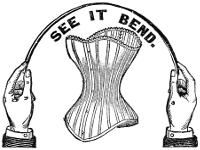
SEE IT BEND.
Why Not Buy a Corset that Fits?
(It costs no more than one that does not.)
Because of its peculiar construction
IT MUST FIT BETTER AND EASIER
than any other style of corset.
THE SECRET??
is that it is MOULDED and not straight stayed.
Do you want to know more about it? Ask your dealer for
it, or write us for descriptive circular. Sample
by mail, postpaid, in Royal Jeans $2.00, or English Sateens
$3.00. All popular colors. Workmanship unexcelled.
Materials highest quality. Can return and money refunded,
after one week’s wear, (white excepted) if not satisfactory.
Mention this Magazine.
CORONET CORSET CO., Jackson, Mich.
Newcomb Fly-Shuttle
Rag Carpet
LOOM
Weaves 100 yards per
day. Catalogue free.
C. N. Newcomb,
365 W. St. Davenport, Iowa.
When writing to advertisers, mention Vick’s Magazine.
HATCH CHICKENS BY STEAM
With the Improved Excelsior Incubator.
Simple, Perfect, Self-Regulating.
Thousands in successful
operation. Guaranteed
to hatch a larger percentage
of fertile eggs at
less cost than any other
Hatcher. Lowest priced
first-class Hatcher made.
Circulars free.
Send 6c. for
Illus. Catalogue.
Geo. H. Stahl, Quincy, Ill.
When writing to advertisers, mention Vick’s Magazine.
NEW CARDS Send 2c. stamp for the LARGEST SAMPLE BOOK of
genuine Hidden Name, Silk Fringe, Envelope & Calling Cards
ever offered. BUCKEYE CARD CO., Laceyville, Ohio.
Derma-Royale is pure, mild and so harmless that a whole bottle may be drank without the least serious effect.
LOVELY FACES, WHITE HANDS.
Nothing will CURE, CLEAR and WHITEN
the skin so quickly as
DERMA-ROYALE
The new discovery for curing cutaneous affections,
removing discolorations from the cuticle and
bleaching and brightening the complexion.
THERE NEVER WAS ANYTHING LIKE IT.
It is as harmless as dew and so simple a child
can use it. It is highly recommended by Physicians
and its sure results warrant us in offering
$500 REWARD—To assure the public of its
merits we agree to forfeit
Five Hundred Dollars cash, for any case of eczema,
pimples, blotches, moth-patches, brown spots, liver
spots, blackheads, ugly or muddy skin, unnatural
redness, freckles, tan or any other cutaneous discolorations
or blemishes, (excepting birth-marks,
scars, and those of a scrofulous or kindred nature)
that Derma-Royale will not quickly remove and
cure. We also agree to forfeit Five Hundred Dollars
to any person whose skin can be injured in the
slightest possible manner, or to anyone whose complexion
(no matter in how bad condition it may be),
will not be cleared, whitened, improved and beautified
by the use of Derma-Royale.
Put up in elegant style in large eight-ounce bottles.
Price, $1.00. EVERY BOTTLE GUARANTEED.
WE WILL BE GLAD TO SEND ANYONE A
ONE DOLLAR BOTTLE FOR NOTHING
TO INTRODUCE IT. ☞ SEND US YOUR FULL POST-OFFICE ADDRESS TODAY
THE DERMA-ROYALE COMPANY, Corner Baker & Vine Streets, CINCINNATI, OHIO.
[75]
FITS CURED
(From U. S. Journal of Medicine.)
Prof. W. H. Peeke, who makes a specialty of Epilepsy,
has without doubt treated and cured more cases than
any living Physician; his success is astonishing. We
have heard of cases of 20 years’ standing cured by him.
He publishes a valuable work on this disease which he
sends with a large bottle of his absolute cure, free to
any sufferer who may send their P.O. and Express address.
We advise anyone wishing a cure to address:
Prof. W. H. PEEKE, F.D., 4 Cedar St., New York
Here’s Your Chance
TO INTRODUCE THE FAMOUS
IMPERIAL WHEELS
we sell samples at absolutely
manufacturers’
prices. Strictly high grade.
All latest improvements. Illustrated
circular free. Great opportunity for
Agents. AMES & FROST CO. CHICAGO, ILL.
Ceylon Teas delighted all at the World’s Fair.
Sample package sent to any part
of the United States for six cents,
with price-list. Goods sent prepaid. Address:
IMPORTERS TEA CO., 60 Wabash Ave., Chicago.
The Rocker Washer
is warranted to wash 100 PIECES IN
ONE HOUR, as clean as can be washed
on the washboard. Write for prices and description.
ROCKER WASHER CO., Ft. Wayne, Ind.
Liberal inducements to live agents.
Asthma
The African Kola Plant
discovered in Congo, West
Africa, is Nature’s Sure Cure
for Asthma. Cure Guaranteed or No Pay. Export
Office 1164 Broadway, New York. For Large Trial
Case, FREE by Mail address KOLA IMPORTING
CO., 132 Vine St., Cincinnati, Ohio.
For Good Living
Send address, and
we mail free our illustrated
booklet, “From Ranch to Table,” a write-up
of the cattle industry of the great plains, from the
“branding of the maverick” to the “round-up” of the
prime steer into Rex Brand Beef Extract.
THE CUDAHY PACKING CO., South Omaha, Neb.
STAMPING ALPHABET FREE!
Send us 10c. for catalogue of BRIGGS STAMPING PATTERNS
and we will send you, free, an alphabet of 26 letters, ready
to stamp. Walker-Johnson Co., Box V. 3, Irvington, N. J.
Sound Discs are invisible, and
comfortable. Relieve more cases of

DEAFNESS
than all devices in the world. H. A.
Wales, 638 Ashland Block, Chicago.
SHORTHAND. You can write sentences
in an hour by the
celebrated non-shading,
non-position, connective vowel PERNIN method.
Read like print; great brevity. Lessons by MAIL. Trial
FREE. Write H. M. Pernin, Author, Detroit, Mich.
Get the Best. New designs for ’94. Lowest
prices. Samples 5 cts. Perfect imitation
stained glass.
AGENTS WANTED.
J. KERWIN MILLER & CO.,
543 Smithfield Street, Pittsburgh, Pa.
YOUR NAME on 25 BEAUTIFUL CARDS
1 AUTOGRAPH ALBUM, 1 RING, 1 KNIFE, 1
Pocket Pencil, 1mt. GOLD PEN & AGENT’S OUTFIT
OF 480 SAMPLE CARDS, SCRAP PICTURES, &c.
ALL 10c. KING CARD CO., NORTH HAVEN, CONN.
PRINT
Your Own
CARDS
Press $3. Circular size $8. Newspaper
size $44. Type setting easy,
printed directions. Send 2 stamps
for catalogue presses, type, cards
&c. to factory. KELSEY & CO.
Meriden, Conn.
A BEAUTIFUL CRAZY QUILT of 500
sq. inches can be
made with our package of 60 splendid Silk and Satin
pieces, assorted bright colors, 25c.; 5 packs, $1.00. Silk
Plush and Velvet, 40 large pieces, assorted colors, 50c.
Emb. silk, 40c. oz. Lemarie’s Silk Mill, Little Ferry, N.J.
WALLPAPER 3 cts. to 50 cts. a roll.
Send 8 cts. for 100 fine
samples. $1 will buy
handsome paper and
border for a large room. THOS. J. MYERS,
1206 Market Street, Philadelphia, Pa.
Care of Fruit Trees.—Are we guiltless if
we always take from the tree and return to it
little or nothing? Has man nothing to do, that
he may receive and enjoy these luscious and
health-giving fruits? Should he merely set the
roots of a tree into the soil and then leave it to
combat with starvation and neglect, as thousands
of trees throughout New England are left to do?
Ride through the country and notice the many
orchards standing, sod-bound and in wet undrained
soil perhaps, with all that can be grown
from the soil in the way of hay and pasture taken
off and not a pennysworth of fertilizer added
to it for the trees. Not a dead limb cut
out, to say nothing of those chafing or growing
crossways, not an insect destroyed; and the
poor tree, how it is trying to do its best while
the owner, who has neglected every essential
thing on his part for successful results, exclaims,
“It don’t pay to raise fruit.” I knew a farmer
who plowed his field for corn and planted it,
but who never cultivated, plowed or hoed it.
He had no corn. Did he deserve any? He
said it did not pay to raise corn. I know another
farmer who prepared his ground nicely for
corn, planted and cared for it intelligently, and
received upwards of a hundred bushels of shell
corn per acre. He was amply paid for his care
and expense. He said it paid him.—Edward
Hoyt before the Mass. Hort. Society.
DEAFNESS & HEAD NOISES CURED
by Peck’s Invisible Tubular Ear Cushions. Whispers
heard. Successful when all remedies fail. Sold
only by F. Hiscox, 853 B’way, N.Y. Write for book of proofs FREE
FREE SPRAY PUMP to one person in each
place. We mean it. If
you mean business and want agency send 10c. We will
send a complete pump that will do the work of any $10
spray. A. SPIERS, Box 51 No. Windham, Maine.
“DON’T MISS IT.”
“Beautiful Women” for 1894, handsomely illustrated,
full of new ideas that are religiously observed by all
Society Bells. Intensely interesting. 25 cts. in stamps or
silver. 246 West 76th Street, New York.
AGENTS WANTED ON SALARY or COMMISSION,
to handle the New Patent Chemical Ink Erasing Pencil.
Agents making $50 per week. MONROE ERASER MF’G
CO., X 506 LaCrosse, Wis.
YOUR NAME on 25 Lovely
Cards, 2 Rings, 1
Handkerchief, 1 Pen
& Holder, 1 Pencil
& Eraser, 1 Scarf Pin, 480
Scrap Pictures, Verses, etc.
Agent’s Outfit of Cards & Novelties, ALL
FOR 10c. GLEN CARD CO, Box D, NORTH HAVEN, CONN.
A WOMAN’S SUCCESS For two years
I have made
$25 a week
at Home. Instructions FREE to lady readers. Send stamp,
(No humbug), MRS. J. A. MANNING, Box 12, Anna, Ohio.
CONSTIPATION CAUSE and CURE.
Address, UNIVERSITY MEDICAL CO., DEPT. A 74
(Treatise mailed free.) 75 43rd St., Chicago, Ill.
SALESMEN WANTED to sell our goods by
samples to the wholesale
and retail trade; sell on sight to every business man
or firm; liberal salary. Money advanced for advertising
and expenses. Permanent position. Address with stamp
KING MF’G CO., A 30, Chicago, Ill.
PILES
Instant relief, final cure in a
few days, and never returns; no
purge; no salve; no suppository.
Remedy mailed free. Address
J. H. REEVES, Box 3290, New York City, N. Y.
YOUR WALL AND OUR PAPER
For Beauty and Economy cannot be excelled. Send 10
cents for postage and receive 100 samples Fine Wall Paper,
with match borders and ceilings.
Wm. Wallace, 1625 Pine St., Philadelphia, Pa.
YOUR FUTURE REVEALED.
Send your name and address to Box W
1692, Boston, Mass., for free book, which
tells you how to read your own fortune.
FREE MUSIC 157 pieces latest Popular Music and
charming Magazine 3 months; all
for 10 cents. American Nation Co., Box 1726, Boston, Mass.

Waverley
The Sensation of the Year
Strictly High Grade.
Warranted One Year.
28-inch size 28 lbs. fitted with Waverley
Clincher Tires, made under
Gormully & Jeffery’s Patents.
Equal to any High Grade Bicycle made, regardless
of price. Full line 24, 26 and 28-inch sizes,
Ladies and Gents. Ask for Catalogue “A,” mailed
free.
INDIANA BICYCLE COMPANY,
7 Street, Indianapolis, Ind., U. S. A.
DO YOU USE
Buttermilk
Toilet Soap
The best, purest and most economical
of all soaps?
A great complexion cleanser, makes your skin
feel new. We want you to try it. At all dealers,
or sample cake by mail 12c.
COSMO BUTTERMILK SOAP CO.
185-187 WABASH AVENUE CHICAGO, ILL.
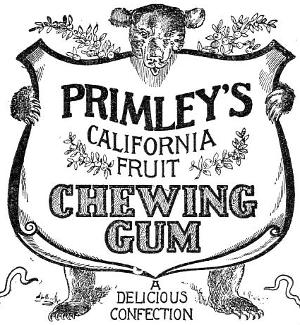
PRIMLEY’S CALIFORNIA FRUIT CHEWING GUM
A DELICIOUS CONFECTION
Makes Sweet Breath, Clean Teeth and Good Digestion.
Heartburn and Dyspepsia disappear on its use. Don’t
make any mistake, get PRIMLEY’S.
Send five outside wrappers of either California Fruit or
California Pepsin Chewing Gum and two 2-cent stamps, and
we will send you “Strange Case of Dr. Jekyll—Mr. Hyde,”
by Robert Louis Stevenson, or any of our other 1700 fine books.
Send for list. For 10 cents and two outside wrappers we will
mail you one elegant pack of our Souvenir Playing Cards.
J. P. PRIMLEY, Chicago, Ill.
ONE CENT
IS THE COST
of information valuable to you if you hold
mortgage or other investment securities
in Colorado, Wyoming, Kansas, Nebraska,
Utah or New Mexico. Address by
postal card or letter
WOLFE, WEBB & CHITTENDEN
INVESTMENT COMPANY,
DENVER, COLORADO.
McMULLEN’S
GALVANIZED WOVEN WIRE
FENCING
WIRE ROPE SELVAGE.
POULTRY & RABBIT NETTING
Railroad, Farm, Garden, Cemetery, Lawn
Fencing. Prices down. Freight paid. Catal’g. free.
McMullen Woven Wire Fence Co., Chicago.
Why suffer longer, when you
can receive free a diagnosis of
your troubles by Dr. Wallace S.
Springsteen. Send at once for
symptom sheet and treatise.
You cannot lose anything,
therefore send now. Something
entirely new in medical
treatment,—successful when
everything else had failed.
SPRINGSTEEN MEDICINE CO.,
381 Central Ave., Cleveland, O.
[76]
MURRAY
VEHICLES and HARNESS
Time Tried and Tested and Endorsed the world
over as the Best and Cheapest on Earth.
| Single Buggy Harness, |
5.95 |
| Double Buggy Harness, |
15.70 |
| Single Farm Harness, |
17.67 |
| Double Farm Harness, |
22.94 |
| Top Buggies, |
55.95 |
| Road Carts, |
14.90 |
| Road Wagons, |
31.75 |
| Spring Wagons, |
43.50 |
| Farm Wagons (2 horse) |
39.50 |
Fine 160 page Catalogue, free.
Wilber H. Murray Mfg. Co., Cincinnati, O.
Turkey red on cotton
that won’t freeze, boil
or wash out. No other
will do it. Package to
color 2 lbs., by mail, 10
cts.; 6, any color—for
wool or cotton, 40c. Big pay Agents. Write quick. Mention
this paper. FRENCH DYE CO. Vassar, Mich.
THE IMPROVED VICTOR INCUBATOR
Hatches Chickens by Steam.
Absolutely self-regulating.
The simplest, most reliable,
and cheapest first-class Hatcher
in the market. Circulars free.
Catalogue 4 cents.
GEO. ERTEL & CO., Quincy, Ill.
Mammoth New Catalogue Almanac
AND GUIDE TO POULTRY RAISERS.
64 large pages, printed in colors. Description
of all leading varieties of fowls. Over
50 fine illustrations. Plans for Poultry
houses. Remedies for all diseases. Recipe
for Poultry Powders. The finest thing
out—everybody wants one. Only 10c.
C. C. SHOEMAKER, Freeport, Ill., U.S.A.
LADIES! If you desire a transparent,
CLEAR,
FRESH complexion, FREE from blotch,
blemish, roughness, coarseness, redness, freckles
or pimples use DR. CAMPBELL’S
SAFE ARSENIC COMPLEXION
WAFERS. These wonderful wafers have
the effect of enlarging, invigorating, or filling
out any shrunken, shrivelled or undeveloped
parts. Price, by mail, $1, 6 Boxes, $5. Depot,
218 6th Ave., New York, and all Druggists.
10 CENTS (silver) pays for our handsome
PEOPLE’S JOURNAL one year,
on trial, and your address in our “AGENTS’ DIRECTORY,”
which goes whirling all over the United
States to firms who wish to mail FREE, sample
papers, magazines, books, pictures, cards etc., with
terms, and our patrons receive bushels of mail. Greatest
bargain in America. Try it, you will be Pleased.
T. D. Campbell, X 118 Boyleston, Ind.
CARDS Send 2c. stamp for Sample Book of all the FINEST and
Latest Style Cards for 1894. We sell GENUINE CARDS
NOT TRASH. UNION CARD CO., COLUMBUS, OHIO.
MESEMBRYANTHEMUM.
The mesembryanthemum, usually called ice-plant,
is one of the most effective border
plants. Nothing can be prettier around a small
bed than a thick edging of these sparkling rich
green plants, and yet I have never seen it used
in this manner except in my own garden. The
plants grow larger, more robust, coarser perhaps,
when used in this way, but they form an
unbroken edge of great richness. Sow the seeds
in the house and transplant when danger of frost
is over; shade for a few days from sun and wind,
and do not let the ground dry out about the roots
until the plants have started into growth again;
after that an occasional watering is all they require.
Treated in this fashion they grow riotously
and yield a wealth of beautiful, cool looking
foliage for bouquets and all kinds of cut
flower work, which has the additional merit of
keeping fresh a long time even under unfavorable
circumstances. One can pick long sprays of
this pretty greenery without it being missed from
the plants in the least. A low glass dish filled
with ice-plant, the sprays drooping over the edges
gracefully, and a few pale pink flowers peeping
out between the leaves, is an exceedingly pretty
center-piece for the dinner table. In putting
out the plants set them about ten inches apart.
Mrs. S. H. Snider.
Vick’s Seeds contain the germ of life. They
grow, flourish and produce abundantly.
CONSUMPTION
SURELY CURED.
To the Editor—Please inform your readers
that I have a positive remedy for the
above named disease. By its timely use
thousands of hopeless cases have been permanently
cured. I shall be glad to send
two bottles of my remedy free to any of your
readers who have consumption if they will
send me their express and post office address.
T. A. Slocum, M. C., 183 Pearl St., New York.
THE NAME TO REMEMBER
when buying a BICYCLE
IS
A. W. GUMP & CO.,
Dayton, Ohio.
$30.00 to $50.00 saved on many new and
second-hand Bicycles. Lists free. Over
2,000 in stock. Cash or time.
AGENTS WANTED.
When writing to advertisers, mention Vick’s Magazine.
100 USEFUL Articles wanted in every family, with
full instructions to Agents. How to
make an easy living. All postpaid for
10 cents. HOME SUPPLY CO., CLINTONVILLE, CONN.
Handy Cobbler
COMPLETE SHOE
and Harness Kit
for home use. Great time
and money saver. Articles
separate cost $6. Price
26 articles, boxed, 20 lbs., $3.
No. 2 without extra harness
tools, 22 articles, 17
lbs., $2. Catalogue free.
Agents wanted. In order
give R. R. or Exp. station
and name this paper.
KUHN & CO., Moline, Ill
BABY CARRIAGES Shipped C. O. D.
| $18.50 |
Carriage |
for |
$9.25. |
| $12.00 |
” |
” |
$5.95. |
| $5.00 |
” |
” |
$2.75. |
Anywhere to anyone at Wholesale Prices without paying
one cent in advance. We pay freight. Buy from
factory. Save dealers’
profits. Large
illustrated catalog
free. Address Cash Buyers’ Union,
164 West Van Buren Street, B 27, Chicago, Ill.

BALD HEADS
NO CURE, NO PAY.
Mustache, No Pay.
DANDRUFF CURED.
CALL OR WRITE
Prof. G. BIRKHOLZ,
Room 4,
Cor. 5th Ave. & 14th St.,
NEW YORK.
LACE. Ladies send 5 two-cent stamps for
samples of fine imported Laces.
We will send free as a premium a piece containing
12 yards of handsome lace for a one year’s subscription
to “OUR COUNTRY HOMES MONTHLY MAGAZINE”
at $1.00 a year. Write us now. Agents Wanted.
We also give as premiums Watches, Jewelry, Books, Albums,
etc., etc. Address Publishers Our Country Homes
Monthly Magazine, 302 & 304 S. Salina St., Syracuse, N. Y.
When writing to advertisers, mention Vick’s Magazine.
480 Sample styles of New Cards &
Premiums for 1894. Agt’s large
Sample Book of genuine Hidden Name, Silk
Fringe, Envelope, Bevel edge & Fancy shape Calling Cards,
all for 2 cents. CROWN CARD CO., CADIZ, OHIO.
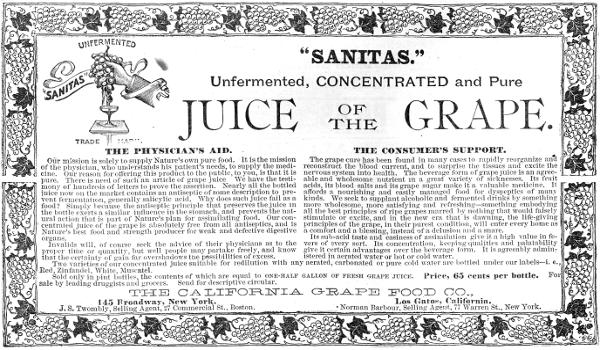
“SANITAS.”
Unfermented, CONCENTRATED and Pure
JUICE OF THE GRAPE.
THE PHYSICIAN’S AID.
Our mission is solely to supply Nature’s own pure food. It is the mission
of the physician, who understands his patient’s needs, to supply the medicine.
Our reason for offering this product to the public, to you, is that it is pure. There is need of such an article of grape juice. We have the testimony
of hundreds of letters to prove the assertion. Nearly all the bottled
juice now on the market contains an antiseptic of some description to prevent
fermentation, generally salicylic acid. Why does such juice fail as a
food? Simply because the antiseptic principle that preserves the juice in
the bottle exerts a similar influence in the stomach, and prevents the natural
action that is part of Nature’s plan for assimilating food. Our concentrated
juice of the grape is absolutely free from all antiseptics, and is
Nature’s best food and strength producer for weak and defective digestive
organs.
Invalids will, of course, seek the advice of their physicians as to the
proper time or quantity, but well people may partake freely, and know
that the certainty of gain far overshadows the possibilities of excess.
THE CONSUMER’S SUPPORT.
The grape cure has been found in many cases to rapidly reorganize and
reconstruct the blood current, and to surprise the tissues and excite the
nervous system into health. The beverage form of grape juice is an agreeable
and wholesome nutrient in a great variety of sicknesses. Its fruit
acids, its blood salts and its grape sugar make it a valuable medicine. It
affords a nourishing and easily managed food for dyspeptics of many
kinds. We seek to supplant alcoholic and fermented drinks by something
more wholesome, more satisfying and refreshing—something embodying
all the best principles of ripe grapes marred by nothing that would falsely
stimulate or excite, and in the new era that is dawning, the life-giving
principles of the grape, in their purest condition, will enter every home as
a comfort and a blessing, instead of a delusion and a snare.
Its sub-acid taste and easiness of assimilation give it a high value in fevers
of every sort. Its concentration, keeping qualities and palatability
give it certain advantages over the beverage form. It is agreeably administered in aerated water or hot or cold water.
Two varieties of our concentrated juice suitable for redilution with any aerated, carbonated or pure cold water are bottled under our labels—i.e.,
Red, Zinfandel, White, Muscatel.
Sold only in pint bottles, the contents of which are equal to one-half gallon of fresh grape juice. Price, 65 cents per bottle. For
sale by leading druggists and grocers. Send for descriptive circular.
THE CALIFORNIA GRAPE FOOD CO.
145 Broadway, New York.
J. S. Twombly, Selling Agent, 27 Commercial St., Boston.
Los Gatos, California.
Norman Barbour, Selling Agent, 77 Warren St., New York.
[77]
MARGUERITE CARNATIONS.
“My first sowing was early in February, 1892.
The plants came into bloom the middle of June,
and I had more or less flowers from them all
through the following winter and spring. In
1893 I made two sowings, one the beginning of
February, and another the end of March, to secure
plants for winter flowering. About eighty
of these in six-inch pots were plunged out of
doors until the middle of November; then removed
indoors and placed in light airy position.
They have been flowering profusely ever since,
and will continue doing so to the end of May.”
These statements are made by John Milne in
the Journal of Horticulture. Another writer
in the same publication says:
“Those who have not yet grown these carnations
have missed much. I sowed some seeds
at the end of February last year in a mild heat,
and the seedlings were potted when large enough,
the bulk of them eventually finding their way
into pots five and a half inches in diameter.
Some few were grown in pots an inch less, but
I noted those in the larger pots were much better
every way. Small pots do not afford sufficient
scope for the roots, as these are freely
made, and being very fibrous they absorb a quantity
of moisture. A moderately rich compost is
essential, the plants requiring a fair amount of
stimulative food to enable them to continue longer
in flower than they do when in a starved condition.
To test these carnations I planted some
in the kitchen garden, but I found that those in
pots flowered much the best. About ninety per
cent. of these carnations come double from seed,
which is a great gain, as single flowers are really
of little use for decorative purposes. What I
admire about them is the large number of self-colored
flowers that are produced. The bulk of
them are deliciously scented, and all fringed at
the edges of the petals. When the weather permitted
the plants were assigned a position out of
doors where they could obtain all available sunlight,
were given plenty of space, and well supplied
with water at the roots. Directly the pots
in which they were to flower were full of roots,
weak liquid manure was supplied to them freely.
By the early part of July they commenced to
flower, and kept on unceasingly until the early
part of November out of doors. Where buttonhole
bouquets are in demand these Marguerite
carnations afford excellent material for the making
of this favorite adornment, and as the carnation
is a popular flower for the purpose this new
race is doubly valuable.”
SITUATIONS WANTED.
Advertisements of gardeners and florists desiring
situations will be inserted under this head free.
A FIRST-CLASS GARDENER AND FLORIST, single,
27 years of age of temperate habits, Hollander, but
speaking English, with the best of reference, wants a situation
as private gardener. Apply to “Hollander,” care
Vick Seed House, Rochester, or at Vander Meulen’s Greenhouses,
Dunkirk, N. Y.
World’s Fair comes to
“THE PAGE”!
At least the President does when he wants fence. Last
month his Manager called on our agent and bought 500
rods. It’s now delivered and paid for, at the same price
you can buy. Plenty of fences “just as good” were
offered at cut rates, but four years’ trial beats a Medal
with Hon. Thomas W. Palmer.
PAGE WOVEN WIRE FENCE CO., Adrian, Mich.
A PRETTY FLOWER STAND.
Here is something you can make for yourself
before another summer comes. This
is a flower stand, and the simplest contrivance!
Saw off an old cedar tree about two feet below
the first branch, then saw it off again about two
feet above the first branch. The thicker the
branches on this unsightly stump the better for
your purpose. The branches must next be
chopped off irregularly, leaving some a yard and
some half a yard in length. Bury the lower end
of the stump about one foot in the ground, and
on the end of each branch nail a piece of board
about ten inches square to serve as a shelf.
These shelves must be firmly nailed so that
boxes or pots can be set upright on them. Now
paint the whole thing green and you have a
pretty flower stand. You will not believe it until
you try it, but it is beautiful. Instead of
bedding out the plants you wish for winter
flowering, try the plan of keeping them on this
stand out of doors during the summer, where
they will get all the benefit of the sun and dew.
On the approach of winter they will only need
to be brought indoors, and will be in a much
better condition for blooming than if they had
been taken up at the risk of breaking half their
roots and potted in a hurry.
Prudence Plain.
$12 TO $35 PER WEEK Can be made by working
for us. Parties preferred who
have a horse and can give their
whole time to our business.
Even spare time will play splendidly.
This announcement is of
special interest to farmers and farmers’ sons, and others
residing in the rural districts. A few vacancies also in
towns and cities.
B. F. Johnson & Co.,
No. 5 South 11th St., Richmond, Va.
MY WIFE CANNOT SEE HOW YOU DO
IT AND PAY FREIGHT.
$14 Buys our 2 drawer walnut or oak Improved
High Arm Singer sewing machine
finely finished, nickel plated, adapted to light
and heavy work; guaranteed for 10 Years; with
Automatic Bobbin Winder, Self-Threading Cylinder
Shuttle, Self-Setting Needle and a complete
set of Steel Attachments; shipped any where on
30 Day’s Trial. No money required in advance.
75,000 now in use. World’s Fair Medal awarded machine and
attachments. Buy from factory and save dealer’s and agent’s profits.
FREE
Cut This Out and send to-day for machine or large free
catalogue, testimonials and Glimpses of the World’s Fair.
Oxford MFG. CO. 342 Wabash Ave. CHICAGO, ILL.
Award of Highest Prize
at World’s Fair, ratified by verdict
of “The Multitude.” Our
“Modern Bath” an ornament and
source of joy in any home. Send 2 cts
for catal’g illust’g 18 styles Tub.
Improved Water Heaters, etc.
MOSELY FOLDING BATH TUB CO.,
181 W. South Canal Street,
CHICAGO, ILL.
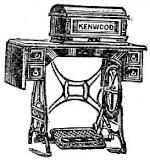
High Arm Warranted Ten Years.
FREE TRIAL in your own home
for 30 days without
paying one
cent in advance; machine to be returned
at our expense if unsatisfactory. We
take all risks, pay freight, ship anywhere,
to anyone, in any quantity at
wholesale prices. $65 Kenwood machine,
$24.50; $55 Arlington, $20.50; $45 Arlington,
$17.50; $35 High Arm Gem, $12. We sell
all makes and styles, from cheapest $7.95
to best “Kenwood,” $24.50. All attachments
free. Three Highest World’s Fair
Medals awarded. Over 100,000 now in use. Buy direct from factory.
Save agents large profits. Catalogue and testimonials free. Write
at once. Address (in full) CASH BUYERS’ UNION
158-164 W. Van Buren St., Dept. A 43, Chicago, Ill.
CHRYSANTHEMUMS
Choice Seed, 25c. packet. Circular free.
T. H. SPAULDING, Orange, N. J.
READER If You Love RARE FLOWERS
choice only, address ELLIS BROS.,
Keene, N. H. It will astonish and please. ☞ FREE
MUSICAL CLOCK & Box Combined.
Runs 8 days,
keeps perfect time
& furnish constantly
all the most
charming & popular
tunes. Plays
anything from a
simple song to a
difficult waltz or
operatic selection.
To introduce it
one in every county
or town furnished
reliable persons
(either sex)
who will promise
to show it. Send
at once to
Inventor’s Co., New York City, P. O. Box 2252.
RARE FLOWERS FREE!
We want all to try our Northern Grown seeds, so for 30
days only we will send the following (well worth $1.00)
FREE:
- Giant Petunias, 5 in. across, beautifully stained.
- Golden Gate Poppies, hundreds of beautiful colors.
- Snowball Pinks, white as winter snows.
- Royal Prize Pansies, 3 inches across, all colors.
Also a 20-cent coupon and our beautifully illustrated
catalogue for 1894. Enclose 6c. for postage, and address
O. M. RICHARDSON & CO., Florists, Canton,
Maine. Mention this paper.
All about Poultry for a 2c. stamp.
S. M. T. JOHNSON, Box 11, Binghamton, N. Y.
DRUNKENNESS Is a DISEASE.
It can be Cured
by administering
Dr. Haines’ Golden Specific. It can be
given without the knowledge of the patient, if
desired, in coffee, tea or articles of food. Cures
guaranteed. Send for circulars. GOLDEN
SPECIFIC CO., 185 Race St., Cincinnati, O.
☞ The Only Cure. Beware of Imitators.
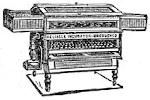
45 Yards High Class Fowls.
THE WORLD’S FAIR Highest Awards,
MEDAL and DIPLOMA,
on our INCUBATOR and BROODER
Combined. If you are interested in
Poultry, it will pay you to send 4 cents in
stamps for 72 page catalogue, giving valuable
points on Poultry Culture. Address
Reliable Incubator Co., Quincy, Ill.
OPIUM Morphine Habit Cured in 10
to 20 days. No pay till cured.
DR. J. STEPHENS, Lebanon, Ohio.
Teeth White as Snow.
I have a simple and harmless
preparation which
will make the teeth pearly white. Sample box 15c. or
sample and recipe of Tooth Whitening 25c., postal note or
stamps.
MATTIE M. CRON, Cromwell, Ind.
AGENTS clear $100 monthly. 100 New
Ladies’ Specialties for Old
and Young. 64 page Illust’d Catalogue
FREE. G. L. Erwin & Co., Chicago, Ill.
LADIES who will do writing for me at their
homes will make good wages. Reply
with self-addressed stamped envelope.
MISS MILDRED MILLER, South Bend, Ind.
WOMEN WHO CAN CROCHET
and have a few hours’ spare time can get work to do at
home to occupy their spare time profitably. Address
L. WHITE & CO., 209 State St., Chicago, Ill.
You can now grasp a fortune. A new
guide to rapid wealth, with 240 fine engravings,
sent free to any person. This
is a chance of a lifetime. Write at once.
Lynn & Co. 48 Bond St. New York

CORNS CURED
FREE.
Send for Free Sample Bottle.
Regular size 25c.
Cohn’s, 332 W. 51 St., N. Y.
☞ For 6 two-cent stamps we will send you
a brilliant Gem of unusual color
and a copy of “The Great Divide,” provided
you write you saw this in Vick’s Magazine.
Address, “The Great Divide,” Denver, Colo.
EUROPE Holy Land, California, Bermuda,
Florida, Mexico, etc. Select parties;
best ticketing facilities; choicest ocean berths. Send
for “TOURIST GAZETTE.”
H. GAZE & SONS, 113 Broadway, New York.
(Est. 1844.) Official Ticket Agents Chief Trunk Lines.
$150.00 for $5.00; genuine Confederate
States greenbacks; in common bluebacks.
Terms 4 cts. A. L. NAPLES, Mulberry, Kansas.
NEW PLAYS
READINGS, RECITATIONS,
CATALOGUES FREE!!!
DE WITT, ROSE ST., N. Y.
GREEN’S Fruit Guide and Catalogue
80 PAGES, 9 COLORS, ILLUSTRATED. Free to all who Apply.
Trees, Plants, Vines, Small
Fruits, Roses, Ornamentals
SIXTY THOUSAND PATRONS. ESTABLISHED 20 YEARS. 2 NURSERIES.
See Green’s Monthly—“Fruit Grower”—Sample
Free. 100,000 Readers. 50 cts. a Year. Address GREEN’S NURSERY CO., Rochester, N. Y.
[78]
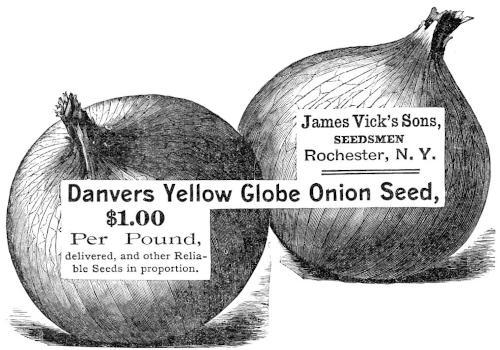
James Vick’s Sons, SEEDSMEN
Rochester, N. Y.
Danvers Yellow Globe Onion Seed, $1.00 Per Pound,
delivered, and other Reliable Seeds in proportion.
Tested and Tried, Proven Good, are
all the Seeds and
Plants we offer.
Vick’s Seeds have “grown” for
over Forty Years, and
will continue to do so.
We Pay the postage or express charges,
except when noted.
VICK’S FLORAL GUIDE, 1894,
112 pages of Flowers and Vegetables,
will be sent for ten cents, which can be
deducted from first order.
HANGING BASKETS.
Only certain kinds of plants are suitable
for hanging baskets; such as are of low
compact growth, to cover the surface, and such
as are of drooping or trailing habit, to hang over
the sides, are best for the purpose. For the center
use some graceful plant of upright growth.
In setting the plants in hanging baskets a layer
of moss at least one inch in depth should be
spread over the bottom and sides, so that the
water may be held and prevented from washing
through. To have the plants bloom freely they
should be hung where they will be exposed to
the sun at least two hours every day, and in dry
weather they need copious watering. A good
plan is to dip the whole basket in water until it is
thoroughly soaked. It can be allowed to drip
before being again hung up. Watered in this
way the soil retains the moisture much better than
when the water is only poured on the plants.
Panicum variegatum is one of the most valuable
plants I have tried for baskets or vases. It
is a species of grass from New Caledonia, of
very graceful habit of growth, with beautiful variegated
foliage striped, white, carmine and
green. The ivy-leaved geraniums are excellent
climbing or trailing plants adapted to hanging
baskets. They have a fine, thick, glossy foliage,
which of itself would warrant their cultivation,
but they also have the charming attraction
of possessing beautiful flowers as well
as foliage. Any one who once succeeds in getting
a good variety started in a basket will never
allow their window garden to be without a plant
of this kind, as they all bloom with the greatest
freedom. Chas. Turner is my favorite variety
of the ivy-leaved geraniums.
Nasturtiums are lovely in a “rustic” hanging
basket, that is, one made of rough and gnarled
roots and limbs of trees. All the varieties of
oxalis are pretty grown in earthenware baskets,
and wire baskets lined with bright green moss
are especially suitable for the different varieties
of tradescantia, or “wandering jew.” There is
a drooping variety of cactus, Cereus flagelliformis,
admirably suited for hanging baskets. I
have seen this planted in a large ox horn suspended
by chains, and it made a most unique
ornament.
Prudence Plain.
The Unemployed in England.—The sufferings
of the unemployed in England, if not
greater, are at least more vocal than ever, and
remarkably various are the remedies proposed.
Besides the project already named, Mr. Keir
Hardie suggested to Parliament the establishment
of an eight hours day and the prohibition
of overtime in Government factories, the reclamation
of waste lands and foreshores, the reafforesting
of the country, and the provision of
suitable accommodation for the aged poor. The
Daily Chronicle revives an old scheme for reclaiming
the Wash, and so adding a “new country”
to England. Mr. Chamberlain’s hope is
for extended markets for national trade. A conference
of vestries, presided over by Lord Onslow,
proposed to Mr. Gladstone the formation
of light railways, made and worked as in Ireland,
to carry away the refuse of London. The
gravity of this problem throughout the United
Kingdom can hardly be overestimated, and its
conditions are not so transient as those in the
United States. There is no such “army of unemployed”
in Chicago or New York as in London.—From
the “Progress of the World,” in
the February Review of Reviews.
TO CATARRH SUFFERERS
A clergyman, after years of suffering,
from that loathsome disease, Catarrh, and
vainly trying every known remedy, at last
found a medicine which completely cured
and saved him from death. Any sufferer
from this dreadful disease sending his
name and address to Prof. Lawrence, 88
Warren Street, New York, will receive the
means of cure free and postpaid.
When writing to advertisers, mention Vick’s Magazine.

Send $2.00 for a large FUR RUG
5½ feet long by 33 inches
wide. Made from selected
skins of the Japanese Angolia.
Long, soft, silky fur.
The colors are Silvery White,
Light Grey and Dark Grey.
☞ We also have a beautiful
Glossy Black Fur Rug
at $3.00. Same size. Comfortable,
luxurious, elegant.
For Parlors, Reception Halls,
or Bed Rooms. Sent C. O. D.
on approval if desired.
THE LAWRENCE,
BUTLER & BENHAM CO.
94 High Street, Columbus, O.
AUTOMATIC SHELL EXTRACTOR
DOUBLE-ACTION

$4.50
WORTH $15.00
HILL—He Pays the Express
on this American-made Revolver.
Full Nickel Plated, Rubber Stock,
Center Fire, 32 or 38 Caliber,
Five Shot, 8-in. long,
rifle barrel 3¼ inch Long
fluted cylinder, Low
curved hammer which
prevents accidental
discharge. Weight
16 oz. Cut this out
and we will ship by
express C. O. D. $4.50,
we pay all charges.
W. HILL & Co.,
207 State Street, Chicago.

Warranted. Light Running.
HIGHEST MEDAL
awarded to
MAJESTIC
Only Medal for
Sewing Machine
Attachments
Why? Send for catalogue
TILTON SEWING MACHINE CO.,
275 Wabash Ave., Chicago
BEAUTIFUL SHAWLS
FREE
Owing to the failure, during
the recent panic, of a
large manufacturer of Fine
Cashmere Shawls we
were enabled to secure an
enormous quantity of Plaid
Shawls at a fraction of the
cost to manufacture, and
propose to give them
away absolutely Free
as follows: To every person
who sends us 25 cents for
one year’s subscription to
MODERN STORIES,
a large 16-page handsomely
illustrated story and family
paper, containing fascinating
stories and a choice
piece of sheet music each
issue, by authors of worldwide
reputation, we will send one shawl absolutely FREE.
Remember there are no conditions, our offer is fair, square
and absolute. Every person who cuts this ad. out and returns
to us with 25 cents for our paper one year gets a shawl
FREE. If you want one send now. Address,
MODERN STORIES, 87 Warren St., New York
When writing to advertisers, mention Vick’s Magazine.
VICKS’ Brilliantly Beautiful INVINCIBLE SWEET PEAS
SUPERIOR SELECTED STRAINS.
We have for several seasons applied our best efforts towards improving, perfecting, as
well as increasing, our stock of the mixture which we introduced last season as “VICK’S
INVINCIBLE,” and which we know will please the most exacting. For flowers of lively
yet delicate colors, varying from the pearly white to the darkest and richest reds and purples,
this “Invincible Mixture” leads because it is the result of culling, season after season,
only the choicest and the best from the flowers of the year previous. The many and various
colored and shaded blooms cannot fail to give perfect satisfaction.
Price, Vicks’ Incredible Mixed Sweet Peas, per packet 15 cents; two for 25
cents; ounce 50 cents.
JAMES VICK’S SONS, Rochester, N. Y.
[79]
TREES AND PLANTS.
Upon our 250 acres of nursery we have every class of hardy Trees and Plants; Fruit, Ornamental,
Nut and Flowering. Mary and Henry Ward Beecher Strawberries and
Lovett’s Best Blackberry are among the most valuable novelties. In our catalogues named
below (which are the most complete, comprehensive and elaborate published by any nursery
establishment in the world) all are accurately described and offered at one-half the
price of tree agents.
LOVETT’S GUIDE TO FRUIT CULTURE tells all about fruits, their merits and
defects; how to plant, prune, cultivate, etc. Richly illustrated. Several colored plates. Price 10c.
LOVETT’S MANUAL OF ORNAMENTAL TREES AND PLANTS is authoritative
as well as instructive; a model of excellence in printing and illustration. Gives
points and plans for ornamental planting. Price, with colored plates, 15 cents.
Established 40 years. We successfully ship to all parts of the World.
All who order either of the above and name this paper will receive an ounce of Flower Seeds free.
J. T. LOVETT CO. LITTLE SILVER, N. J.
SPRAY YOUR FRUIT TREES & VINES
Stahl’s
Double Acting
Excelsior Spraying
Outfits prevent
Leaf Blight & Wormy
Fruit. Insures a heavy
yield of all Fruit and
Vegetable crops. Thousands
in use. Send 6 cts. for
catalogue and full treatise
on spraying. Circulars free.
WM. STAHL, Quincy, Ill.
GIVE UP TRYING TO GET SATISFACTORY RETURNS FROM POOR SEEDS.
Vicks’ Seeds Contain the Germ of Life
THEY GROW—THEY FLOURISH—THEY PRODUCE ABUNDANTLY.
SOW VICKS’ SEEDS AND REAP GLORIOUS REWARDS.
You Get the Best only from JAMES VICK’S SONS, Rochester, N. Y.
$120.00 PER MONTH
IN YOUR OWN LOCALITY
made easily and honorably, without capital, during your
spare hours. Any man, woman, boy or girl can do the
work handily, without experience. Talking unnecessary.
Nothing like it for money making ever offered before. Our
workers always prosper. No time wasted in learning the
business. We teach you in a night how to succeed from
the first hour. You can make a trial without expense to
yourself. We start you, furnish everything needed to carry
on the business successfully, and guarantee you against
failure if you but follow our simple, plain instructions.
Reader, if you are in need of ready money, and want to
know all about the best paying business before the public,
send us your address, and we will mail you a document,
giving you all the particulars.
TRUE & CO., Box 1398, Augusta, Maine.
When writing to advertisers, mention Vick’s Magazine.
DO YOU GROW “POSIES”
If so, send for Catalogue
of PLANTS & SEEDS,
and compare with others
before you order. We
send a packet of our celebrated “PRIZE” ASTERS
Free, with Catalogue, if you mention this paper.
Address, The CALLA GREENHOUSES, Calla, O.
SEEDS FREE FOR TRIAL
We have the Finest and
Cheapest Seeds to be found
in the world and we want
every reader of this paper to try one of the following
collections Free. They would cost you
from 75c. to $1.00 purchased elsewhere.
1st FREE OFFER, Vegetables, 1 pkt. each.
- BEET, Mitchell’s Blood Turnip, earliest and best.
- CABBAGE, Surehead, sure to head.
- CELERY, Golden Self Blanching, the best.
- LETTUCE, Denver Market, fine new sort.
- WATERMELON, Dixie, luscious, great bearer.
- ONION, Selected Globe Danvers, standard sort.
- RADISH, Summer Varieties, 15 choice kinds.
- SQUASH, Fordhook, best, new sort.
- TOMATO, Picture Rock, a grand tomato.
2d FREE OFFER, Rare Flowers.
- FORGET-ME-NOT, New Giant Flowered, large.
- CANDYTUFT, Fancy Mixture, best bouquet sorts.
- CALENDULA, Double White, very showy.
- CLARKIA, Salmon Queen, richest col’d double.
- CHRYSANTHEMUM, White Bouquet, fine flower.
- GAILLARDIA, Perpetual Flowered, rich, showy.
- POPPY, Riverdale Mixture, fancy sorts only.
- SCABIOSA, Dwarf, Double Striped, lovely, grand.
- SNAPDRAGON, Show Mixed, penciled blossoms.
- ORNAMENTAL GRASSES, 25 choice sorts.
Either of the above collections, (9 packets Vegetable
seeds, or 10 packets flower seeds) Mailed
Free on following conditions: Send us 10c. for
either of above collections, or 20c. for both, and
we will mail them to you; also “Book on Summer
Gardening,” and include in each lot a check
for 10c. This check you can return to us at any
time and get 10c. worth of seeds, thus the collection
really costs you nothing. (We charge this
10c. to prevent people from sending who have no
use for the seeds.) We want you to try our seeds.
☞ Both collections, book, and packet each of
the lovely early Carnation Marguerite and
profuse blooming Begonia Vernon and a 25c.
check for 25c. Book free to seed buyers.
J. J. BELL, Flowers, Broome Co., N. Y.
SEEDS BOX WORTH $3.50
35 Regular Size Packets, ONLY 50 CENTS.
The great demand for our 50 cent Complete Garden Collections in years past induces us to
offer the same again. Many who have tried every collection they have seen advertised, pronounce this
the greatest bargain they have ever obtained. Our Seeds are the Best and Cheapest, and we
offer these Great Inducements to get Everybody to Try Them. This Great COMPLETE
GARDEN Box contains One Packet each,
- ASPARAGUS, Barr’s Mammoth, giants, good qual.
- BUSH BEAN, Rust Proof Wax, best bean grown.
- POLE BEAN, Golden Champion, productive, good.
- CABBAGE, All Head, large, sure header.
- CUCUMBER, New Everbearing, early, productive.
- CORN, White Cory, earliest, best, sweetest.
- LETTUCE, Grand Rapids, best forcing.
- MUSKMELON, Netted Gem, unsurpassed quality.
- WATERMELON, Dixie, luscious; has no equal.
- ONION, Early White, early, sure cropper.
- PEAS, Bell’s Extra Early, best early.
- PARSNIP, Improved Guernsey, best for table use.
- RADISH, 15 Choice Summer Sorts. Mixed.
- SQUASH, Fordhook, best for general use.
- TOMATO, New Stone, solid, large, good.
- 5 PACKETS Other Choice Vegetables.
15 PACKETS Choice Flower Seeds, including such sorts as Cozy’s Canna, Sweet Nicotiana, Etc.
All the above, (best outfit for a complete vegetable and flower garden ever offered)—20 full packets
choice vegetables, and 15 packets rare flowers in a box with our new Book on Summer Gardening
by mail postpaid for only 50c. Send for it. Address, J. J. BELL, Flowers, Broome Co., N. Y.
CHOICE ROSES AT 5 Cts.
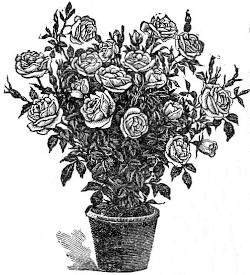
Good & Reese’s Roses are on their own roots.
OUR RAINBOW COLLECTION
OF 20 ROSES FOR $1. PREPAID BY MAIL.
The roses we send are on their own roots, from 10 to 15
inches high, and will bloom freely this summer either in pots
or planted in yard. They are hardy, ever bloomers. We send
instructions with each order how to plant and care for them.
Please examine the below list of 20 choice fragrant monthly
roses, and see if you can duplicate them anywhere for an
amount so small as $1. They are nearly all new kinds.—We
guarantee them to reach you in good condition, and we also
guarantee them to be the best dollar’s worth of roses you
have ever purchased. THE RAINBOW COLLECTION OF 20
ROSES FOR ONE DOLLAR MUST BE ORDERED COMPLETE.
The List:—Bridesmaid, the best pink rose by far ever introduced.
Princess of Wales, amber yellow, deepening to orange. Snowflake,
pure white, always in bloom. Princess de Radziwell, lovely coral red.
Pearl of the Gardens, deep golden yellow. Beauty of Stapleford,
bright rosy crimson. Queen of Fragrance, in clusters of six to ten roses,
white edged pink. Rheingold, beautiful shades of saffron and tawn. Sunset,
golden amber, resembles an “afterglow.” Dr. Grill, coppery yellow and fawny
rose. Duchess Marie Immaculata, an intermingling of bronze, orange, yellow,
pink and crimson. Lady Castlereagh, soft rosy crimson and yellow. Papa
Gontier, lovely dark red. Star of Gold, the queen of all yellow roses. Waban,
a great rose in bloom all the time. Lady Stanley, great garden rose. Viscountesse
Wautier, one of the best roses grown. Cleopatra, soft shell pink, lovely.
Sappho, fawn suffused with red. Letty Coles, very chaste and beautiful.
THE PROOF OF THE PUDDING IS IN THE EATING.
This applies to Floral matters
as well as to matters culinary.
Ballinger, Texas, Nov. 29.
The Good & Reese Co., Springfield. O. Gentlemen:
The 20 ever blooming roses you sent me for $1. arrived
yesterday in the most splendid condition, and allow me
to say that I was absolutely surprised at the size of the
stalks and the amount, length and thriftiness of the
roots. I have wondered many times how you could afford
to send out such roses for such a small price. Every
home in the land should have their yard full of ever
blooming roses at this price.
Yours,
(Judge) C. H. Willingham.
Pittsburgh, Pa., Sept. 20, 1893.
The Good & Reese Co., Springfield, O. Gentlemen:
I wish to thank you for the excellent assortment of
roses contained in your Rainbow Collection. On May
3, I planted them, 19 of them lived. About six of them
bloomed in June, since which all have bloomed either
monthly or perpetual, true to their color. On Sept. 1, I
counted 106 buds and blooms on the 19 roses. They were
much admired by my friends and neighbors, and allow
me to thank you for furnishing this source of pleasure
so cheaply.
Very respectfully,
E. D. Smith.
82 Fifth Avenue.
We will also send our Iron Clad Collection of 12 Hardy Roses, all different colors, $1. Try a set.
20 Chrysanthemums, all prize winners. $1. 16 Geraniums, double and single, flowered and scented, $1.
12 choice Begonias, different kinds, $1. 40 packets choice Flower Seeds, all different kinds, $1. Our
handsome, illustrated, 152-page Catalogue, describing above Roses, Plants and all Seeds, mailed for 10c. stamps.
Don’t place your order before seeing our prices. WE CAN SAVE YOU MONEY. We have large two year old
Roses for immediate effect. Liberal Premiums to club raisers, or how to get your seeds and plants free. We
are the LARGEST ROSE GROWERS IN THE WORLD. Our sales of Rose Plants alone last season
exceeded a million and a half. When you order Roses, Plants and Seeds, you want the very best. Try us. Address
GOOD & REESE CO., Box 44 Champion City Greenhouses, Springfield, Ohio.
[80]
Peach Yellows.—This disease is making
considerable trouble in certain parts of the country.
It attacks trees about the time they are
coming to the age of most prolific bearing to such
an extent that in certain portions of the peach-growing
regions healthy old trees are unknown.
The symptoms of the disease are: Yellowish-green
color of leaves; small leaves tinged with
red; the new shoots small, wiry, and clustered,
especially when growing upon the trunk or larger
branches; fruit ripens prematurely, is highly colored,
and insipid or bitter to the taste. The
sickly yellowish-green foliage may be due to injury
or lack of nourishment, but when coupled
with the other characters given the presence of
the “yellows” can be considered as certain.
The only sure way is to dig out and burn every
tree as soon as it is seen to be affected. This
plan has been followed in Michigan, where, between
1870 and 1880, the disease was very bad.
Now hardly a case of “yellows” can be found
in many of the peach regions. Constant attention
and prompt action have proved successful,
in this case, at least.
SELECTED SEEDS 8 pkts. for 25 cents.
Sweet Pea, Aster,
Pansy, Phlox, Poppy, Petunia, Zinnia, and Marguerite
Carnation (or 60 Oxalis Bulbs). G. T. GRAEFF, Box
1576, Philadelphia, Pa.
$5.00 Worth for $1.00!
“The Cream of New Chrysanths.”
Pres. Smith, Maud Dean, Kate Brown, G. W. Childs,
Nivens, Mrs. F. L. Ames, Hicks Arnold, Golden Gate.
This set of 8 Gems $1.00; 6 sets $5.00, by mail. Mention
this Magazine, and we will give you free 2 Choice Carnations.
McMULLEN & PASFIELD,
20 Bedford Avenue, Brooklyn, N. Y.
Straws show
which way the wind
blows. Watch them—and
be convinced. When you see all sorts
of washing powders patterned
after Pearline; when you see it
imitated in appearance, in name,
in everything except merit; when
you find three persons using Pearline
where two used it a year ago; when you hear it as
a household word with the best housekeepers; when
you find its former enemies now its staunchest friends;—then
you may know the wind is taking you along
toward Pearline.
Why not go with it? You are losing money by
trying to head the other way; money, and labor,
and time and patience.
Go with the rest—use Pearline—and you stop
losing, and begin to gain. Millions realize that there
is everything to gain and nothing to lose—with
Pearline.
Blowing
Peddlers and some grocers will tell you, “this is as good
as” or “the same as Pearline.” IT’S FALSE—but what a
puff for Pearline.
JAMES PYLE, New York.
The Innisfallen Greenhouses
Have been favorably known for more than
twenty years, and always give satisfaction. In order
to increase my business, I make the following
SPECIAL OFFERS
which are
marvels of
cheapness.
NEW EVER-BLOOMING
DWARF CALLA,
“THE GEM”
This is a novelty of great merit. The only objection to the old
variety is that it sometimes grows tall and scraggly, but the
“Little Gem” is of strong and dwarf habit. The foliage
which is of a lustrous dark green is in great abundance. The
flowers are produced in the greatest profusion, being literally an
ever-bloomer, it will bloom freely all summer in the open
ground, in September it can be lifted and potted and will continue
blooming all winter. The “Little Gem” Calla will continue
to grow and bloom for years without ceasing, and the quantity
of flowers which a large plant will produce is astonishing, the
flowers are snowy white in color, and of good size, it seldom grows
higher than fifteen inches. Price for plants that will bloom this
season, 30 cents each. For $1.00 I will mail 5 plants
to one address.
ONLY $1.00 will buy any one of the collections
named below, delivered
safely by mail, postpaid, to any address. The collections are all
fine, strong plants of the best varieties and are marvels of cheapness.
Every plant is plainly labeled, and there are no two varieties
alike in the same collection.
FOR $1.00 I will mail FREE 20 Prize-winning Chrysanthemums; 20 fine Single
and Double Flowering Geraniums for $1.00; 20 Choice Ever-Blooming
Carnations for $1.00; 20 Flowering Begonias for $1.00; 20 Assorted Flowering Plants
for $1.00; 20 Fancy Leaved Coleus for $1.00.
For $5.00 you can select any six of the above Collections.
To every one who sends an order from this advertisement and mentions this magazine, we will send FREE
a valuable plant.
ORDER NOW and ask for our CATALOGUE of BEAUTIFUL FLOWERS for 1894.
CHARLES A. REESER, INNISFALLEN GREENHOUSES, SPRINGFIELD, O.
FREE A MAGNIFICENT PREMIUM PACKAGE of FLOWER SEEDS. Do YOU read this
magazine? Vick’s Magazine says its readers comprise the best people in the land. Everybody knows
that’s so. We want to make you our own friend, and are willing to make it worth your while to get
acquainted. So, if you will send us 10 cents, for 3 months subscription to Homes and Hearths, we will send
you as a present, transportation prepaid, our unequalled Premium Package, containing 200 choice, fresh, guaranteed
varieties of flower seeds from largest growers, including Sweet Peas (Boreatton, Grand Blue, Queen of England,
Isa Eckford, etc.), also Pansies (Rex, Gold Margined, Snow Queen, etc.), Asters (Jewel, Perfection, Victoria, etc.),
and many others. The whole is a perfect wealth of flowers, fit for a royal garden. Homes and Hearths is an attractive
16-page monthly, with lovely original illustrations, splendid and absorbing original stories: special departments
for news about dress, FASHIONS and for HOME DECORATION; best selected matter; FIRESIDE FUN; a perfect
Mine of pleasure and value. The cash premiums which you will find in it are the most liberal ever made. Address
HOMES AND HEARTHS PUB. CO., New York.
Poppies FREE. Send us 10 cents for a sample
copy of INGALL’S MAGAZINE
and we will send you a “YARD OF
POPPIES,” all in their Beautiful
Colors—FREE. Address J. F.
Ingalls, Lynn, Mass. Box H2
A FINE ROSE And packet of beautiful
FLOWER SEEDS,
with catalogue, for 10c.
ALFRED F. CONARD, Box 5, 10 West Grove, Pa.
Late President Dingee & Conard Co.
850,000 GRAPE VINES
100 Varieties. Also Small Fruits, Trees, &c. Best
rooted stock. Genuine, cheap. 2 sample vines mailed for 10c.
Descriptive price-list free. LEWIS ROESCH, Fredonia, N. Y.
INDEX.
| A Cottage Lot |
69 |
| Architects, Curious, |
66 |
| Begonias, Perhaps |
74 |
| Book Notice— |
| Our Native Grape |
72 |
| Calla, A Yellow-Flowered, |
72 |
| Cannas, The New French, |
68 |
| Don’t Forget the Potatoes |
73 |
| Flower Stand, A Pretty, |
77 |
| Fruit Trees, Care of, |
75 |
| Growing Onion Sets |
73 |
| Hanging Baskets |
78 |
| Letter Box— |
| Lady Washington and Other Plants |
70 |
| Roses in Kansas |
70 |
| Ixia—Spider Lily |
70 |
| Plants About a Fish Pond |
70 |
| Osage Orange Hedge |
70 |
| Vase in a Cemetery |
71 |
| Carnations in the House |
71 |
| Madeira Vine |
71 |
| Mildew on Cucumber Vines |
71 |
| Moles |
71 |
| Pine Apple Air Plant |
71 |
| Phyllocactus latifrons |
71 |
| Mammoth Freesias |
71 |
| Wormy Raspberries—Violets—Storing Cauliflower |
71 |
| Mabel Ray’s Lesson |
65 |
| March Work |
72 |
| Marguerite Carnations |
77 |
| Mesembryanthemum |
76 |
| Peach Yellows |
80 |
| Plant Bed, The, |
72 |
| Poetry— |
| March |
65 |
| Vick’s Flowers |
68 |
| Lines to a Skunk Cabbage |
68 |
| Rose Leaves |
69 |
| The Difference |
68 |
| Unemployed in England, The, |
78 |
| Illustrations— |
| Birds Nests |
66, 67 |
| Plan of Grounds |
69 |
D. and C.
ROSES
Will grow anywhere, with a little
sunshine, water, and care. You can
learn how to grow them, and every
other flower of import, from our
New Guide to Rose Culture
for 1894. If you so request, we will send
free, this book and a copy of our Floral
Magazine, ‘Success with Flowers.’
The Dingee & Conard Company,
West Grove, Pa.
When writing to advertisers, mention Vick’s Magazine.
A BARGAIN Collection of Flower Seeds
19 Choice Annuals (everybody’s favorites), all new
fresh seeds, sure to grow and bloom this season.
Pansy, 40 colors and markings; Phlox, 10 colors; Verbena,
18 colors; Pinks, 10 colors; Petunia, 10 colors; Asters,
12 colors; Balsam, 8 colors; Mignonette Sweet mixed
Sweet Peas, 12 colors and Sweet Alyssum.
FOR 12 CENTS and the name and address of two
of your friends who grow flowers,
I will send, post-paid, the complete collection, one
pkt. each of the ten varieties (enough for any ordinary
garden.) This is a BONAFIDE offer, made to introduce
my home grown flower seeds to new customers
and which I guarantee to please you or the amount
paid refunded, and the seeds given as a present.
Address, Miss C. H. LIPPINCOTT,
319 and 323 Sixth Street, South, MINNEAPOLIS, MINN.
SEEDS GIVEN AWAY
FOR TRIAL. I have found that the best way to advertise
good Seeds is to give away a sample for trial.
If you will send me a 2-cent stamp to pay postage, I will
mail free one package, your selection, of either Cabbage,
Carrot, Celery, Cucumber, Lettuce, Musk or Water Melon,
Onion, Parsnip, Pepper, Pumpkin, Radish, Spinach,
Squash, Tomato, Turnip, or of Flower Seeds—Aster, Balsam,
Celosia, Carnation, Mignonette, Pansy, Phlox, Poppy,
Sweet Peas, Zinnia, or Verbena, and one of my 1894 Catalogues.
Under any circumstances do not buy your Seeds
until you see it, for I can save you money. Over 200,000
people say my seeds are the cheapest and best. I have
earliest vegetables on record. Discount and large prizes
to agents. 50 cents worth of Seeds free with $1.00 order.
Write to-day. F. B. MILLS, Box 30, Rose Hill, N. Y.
ELEGANT PALMS
From India and the Isles of the Sea.
5 Glorious Plants, different sorts, post paid,
60c. These will grow and flourish everywhere.
PALM SEED.
It is child’s-play to make them grow.
Send 5c. postage for our great catalogue,
(130 pages); or catalogue and one large
package of 5 different kinds of Palm seed,
free for 20c. postage. 100 packages $10.
A child can sell 100 packages in two evenings
after school and make $5.00.
JOHN A. SALZER SEED CO. LA CROSSE, WIS.
NORTH STAR CURRANT
is perfectly hardy; will stand any climate;
strongest grower—3 to 4 feet in one summer.
Fruit Large, sweet, most delicious flavor.
Berries do not shell or drop off; most
prolific. Picks 25 per cent. more fruit. Full
particulars and fine colored plates free.
THE JEWELL NURSERY CO.,
Nursery Ave. 39, Lake City, Minnesota.
When writing to advertisers, mention Vick’s Magazine.
FREE Catalogue HOME-GROWN
NORTHERN SEEDS
Guaranteed fresh and reliable.
Large pkts. 2 to 5 cts. Direct from
Grower. Novelty presents with
every order. Catalogue, Free—or
with 2 packets Seeds, 5 cents;
35 packets, $1.00. Send to-day.
A. R. AMES, Madison, Wis.
Banquet Strawberry.
Equal to wild berry in flavor. CROSBY PEACH,
frost proof. Fruits every year. Colored Plates.
Full descriptions. Free Catalogue. All fruits. Write at
once. HALE BROS., South Glastonbury, Conn.
CONARD’S SUNSHINE PANSIES
and Red, White and Blue
SWEET PEAS are the best. 1 pkt. each, 2 for 10c.
Large pkts. 2 for 20c., with catalogue. Alfred F. Conard,
Box 5, West Grove, Pa., Late Prest, Dingee & Conard Co.
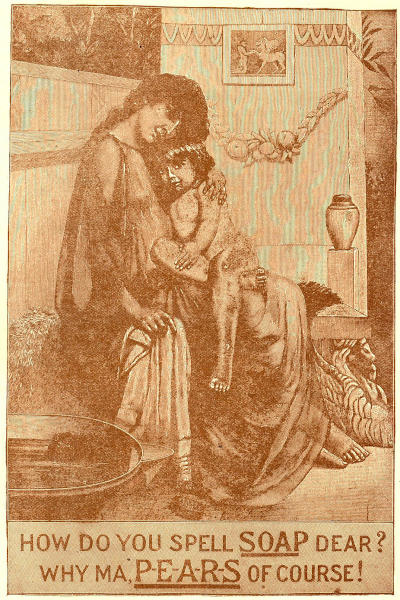
HOW DO YOU SPELL SOAP DEAR?
WHY MA, P-E-A-R-S OF COURSE!
SEEDS A $3.00 BOX of NEW, RARE and BEAUTIFUL FLOWERS FREE
HARD TIMES OFFER—We know that
one trial will convince you that we have the
BEST as well as the CHEAPEST Seeds to be found anywhere in America, so we will mail you
FREE for trial the following 15 Packets of Choice Seeds and two Grand Bulbs;
1 BEAUTIFUL SPOTTED GLADIOLUS BULB, sure to bloom. 1 EXCELSIOR TUBEROSE BULB, Lovely and
Fragrant, ☞ BELL’S Show Mixtures are Finest and Rarest Sorts in the World.
- ASTER, Bell’s Show Mixture.
- PINK, Bell’s Show Mixture.
- VERBENA, Bell’s Show Mixture.
- PETUNIA, Bell’s Show Mixture.
- PHLOX, Bell’s Show Mixture.
- ALYSSUM, White Wave, Choice White.
- CALLIOPSIS, Golden Wave, Extremely Showy.
- PANSY, Bell’s Ever-blooming Greenland, Brilliant.
- COLUMBINE, Queen Victoria, Choice New D’ble.
- BUSH MORNING GLORY, Double Violet, Pretty.
- GODETIA, Double Show, New Double, Rare.
- WONDERFUL MEXICAN PRIMROSE, Worth 25c.
- LINUM, Perpetual Flowering, Blooms all Summ’r
- SWEET PEAS, Beautiful Home Mixed, Large Flower
- HARDY ANNUALS, 400 Choice Sorts, Mixed.
☞ All the above 15 Packets Seeds and 2 Bulbs Mailed FREE on the following conditions;
(This is to prevent people sending who have no use for them). Send
us 25 Cents and we will mail all the above, postpaid, with our “Book
on Summer Gardening,” and send you in the box a check for the
25 cents; this check you can return to us and get 25cts. worth of Seeds
at any time. So you see the box of Seeds costs you nothing. We have
1200 of the choicest varieties and do this to get your patronage. Book
mailed free on application to all seed buyers. Address, J. J. BELL, Flowers, Broome Co., N. Y.
GRAND BOX FREE.
SEND FOR IT.
LOVELY FLOWERS
EASILY GROWN.
JOSEPH GILLOTT’S STEEL PENS.
THE MOST PERFECT OF PENS.
Gold Medal, Paris Exposition, 1889,
AND THE AWARD AT THE WORLD’S COLUMBIAN EXPOSITION, CHICAGO.
VICKS’ SEEDS ARE GUARANTEED TO CONTAIN THE GERM OF LIFE.
The Greatest Medical Discovery
of the Age.
KENNEDY’S
MEDICAL DISCOVERY
DONALD KENNEDY, OF ROXBURY, MASS.,
Has discovered in one of our common
pasture weeds a remedy that cures every
kind of Humor, from the worst Scrofula
down to a common Pimple.
He has tried it in over eleven hundred
cases, and never failed except in two cases
(both thunder humor). He has now in his
possession over two hundred certificates
of its value, all within twenty miles of
Boston.
A benefit is always experienced from
the first bottle, and a perfect cure is
warranted when the right quantity is taken.
When the lungs are affected it causes
shooting pains, like needles passing
through them; the same with the Liver or
Bowels. This is caused by the ducts being
stopped, and always disappears in a week
after taking it.
If the stomach is foul or bilious it will
cause squeamish feelings at first.
No change of diet ever necessary. Eat
the best you can get, and enough of it
Dose, one tablespoonful in water at bed-time.
Read the Label. Send for Book.
The “Charmer” Pea
Pleases Everybody Because:—Very Productive;
Highest Quality; Fine Flavor; Staying Qualities;
Great Merit; Deep Green Color, Large Peas,
Closely Packed; Nine in a Pod.
This new variety of large podded, handsome Table Pea,
introduced by us, jumped at a bound into instantaneous
favor all over the United States.
The plants stand from three and a half feet to four feed
high, and bear large, long pods, mostly in pairs, which are
packed remarkably close with flattened, greenish-white,
wrinkled peas, and these, when cooked, are of the finest
flavor and color. The weight of the Pea compared to the
pod is much greater than usual, producing more shelled peas
than any other variety.
In season it follows Little Gem and comes before Champion
of England. Both for the market and family garden
this Pea will be found of the highest merit.
Everybody is charmed with this variety, and whether for
private use or marketing, a liberal quantity should be planted.
Price, per packet 10 cents; per pint 30 cents; per
quart 50 cents.
Vick’s Pea, King of the Dwarfs.
This new seedling, introduced by us, in season follows closely McLean’s Little
Gem, coming into market in the space intervening between the early and the late
varieties. The vines are sturdy and remarkably vigorous, growing about two inches
taller than the Little Gem, and bearing a profusion of pods and Peas in the
pod, with all of the principal dwarf varieties, including the American Wonder, we
find that the King of the Dwarfs outyields them all by 20 per cent., all planted at the
same time, on the same soil, with equal cultivation.
It is a cross between American Wonder and McLean’s Little Gem, and is the most
promising of forty different seedlings. In flavor it is unsurpassed.
Price, per packet 15 cents; per pint 75 cents; per quart $1.25.
JAMES VICK’S SONS, Rochester, N. Y.
VICKS’ SEEDS DO NOT DISAPPOINT. THE HARVEST IS GREAT.
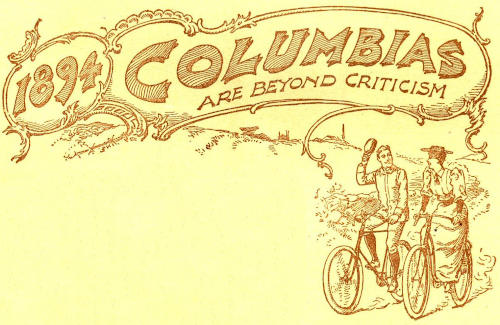
1894 COLUMBIAS ARE BEYOND CRITICISM
No bicycle ever made at all approaches them in
beauty and style joined to excellence of construction,
none so strongly appeals to the experienced
rider as meeting every requirement of a perfect
mount.
The need of repairs for Columbias will be infrequent
under our new system of inspection, which
now begins with a scientific analysis of the raw
material by a metallurgist, and only ends when
thorough tests have been made of the complete
machine and all its parts.
1894 Standard Price, $125.00.
Seven newly designed wheels are shown
in our 1894 Catalogue which will interest
every cyclist. Our agents furnish it free,
or we mail it for two two-cent stamps.
POPE MFG. CO.
BOSTON, NEW YORK,
CHICAGO, HARTFORD.
BRIGGS PIANOS. Celebrated for their Beautiful Tone, Action,
Design, and Great Durability.
Easy Terms. Old instruments taken in exchange.
Write for Catalogue and Full Information.
BRIGGS PIANO CO. 621 Albany Street, Boston, Mass
*** END OF THE PROJECT GUTENBERG EBOOK 63196 ***

